The Law of Moses in the Book of Mormon
You can watch this presentation by Dr. Lund on You Tube
https://www.youtube.com/watch?v=nnxK3kszMPM&feature=youtu.be

Wherefore, verily I say unto you that all things unto me are spiritual, and not at any time have I given unto you a law which was temporal; neither any man, nor the children of men. D&C 29:34.
The Law of Moses as originally given to Moses was a spiritual pathway to prepare the people to accept the “True” Atonement-Centered, Example-Centered Messiah.[1] From 1 Nephi 1:1 on page 1 to 3 Nephi 15:4 on page 437 of the 1981 edition of the Book of Mormon, the American exilic Jews were living under the Law of Moses. Minus the thirty pages of the Book of Ether, 82% of the Book of Mormon is under the Law of Moses.
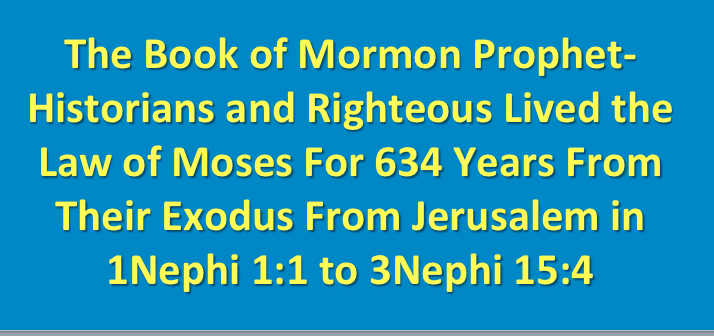
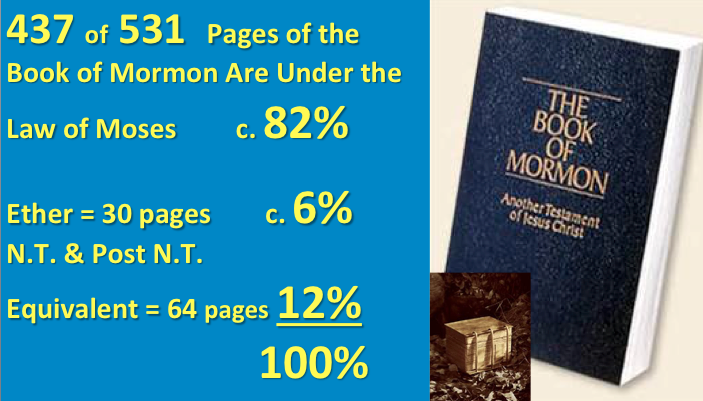
The Apostle Paul said it best” “the law was our schoolmaster to bring us unto Christ” (Galatians 3:24). Every “jot and tittle,” every requirement, performance, and ordinance in the Law of Moses related in one way or another to the dual missions of Jesus Christ. The Lord, even the supernal Jehovah came to earth as the Only Begotten Son of God to conquer death and hell through the Atonement. He came as the son of Mary, to mark the path, lead the way and every point define as mankind’s great Exemplar.
How grateful we should be that God sent his Only Begotten Son to earth to do at least two things that no other person could have done. The first task Christ did as a perfect, sinless Son was to redeem all mankind from the Fall [of Adam], providing an atonement for Adam’s sin and for our own sins if we will accept and follow him. The second great thing he did was to set a perfect example of right living, of kindness and mercy and compassion, in order that all of the rest of mankind might know how to live, know how to improve, and know how to become more godlike. Let us follow the Son of God in all ways and in all walks of life. Let us make him our exemplar and our guide.[2]
The Law of Moses illustrated, through ordinances or performances, the mortal mission and the divine mission of Jesus Christ. The performances and cleansing ordinances the priests would perform “were in many points symbolical.”[3] His mortal life, his death, and the Atonement were reflected in the performances and ordinances of the Law of Moses, in the Messianic teachings of the Prophets, and in the poetry of the Psalms. The Prophet Joseph Smith taught that the Law of Moses “enabled them to look forward to the time of the coming of the Savior and rejoice in His redemption.”[4] Many times, the tiniest of details and requirements of the Law of Moses, pointed toward specific aspects of the coming of the Messiah among men.

An example of how the Law of Moses mirrored key elements of the life and Atonement of Jesus can be found in the cleansing of a leper. Leviticus chapters thirteen and fourteen deal with the identifying of leprosy and the cleansing of lepers.[5]
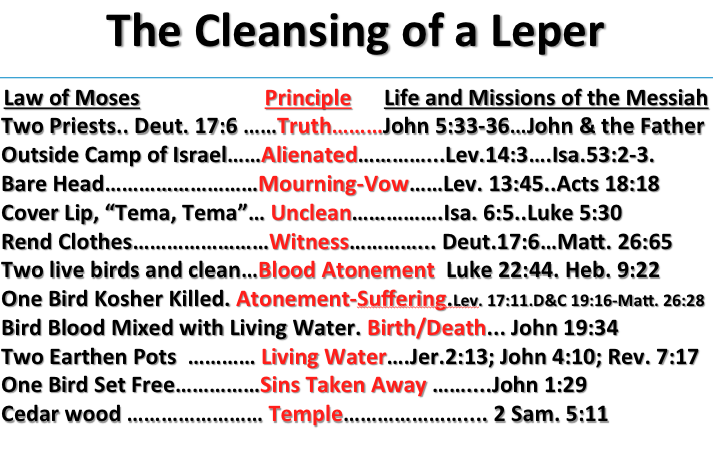
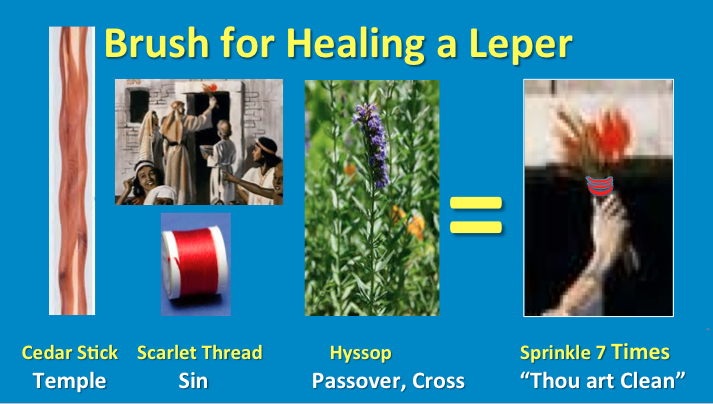
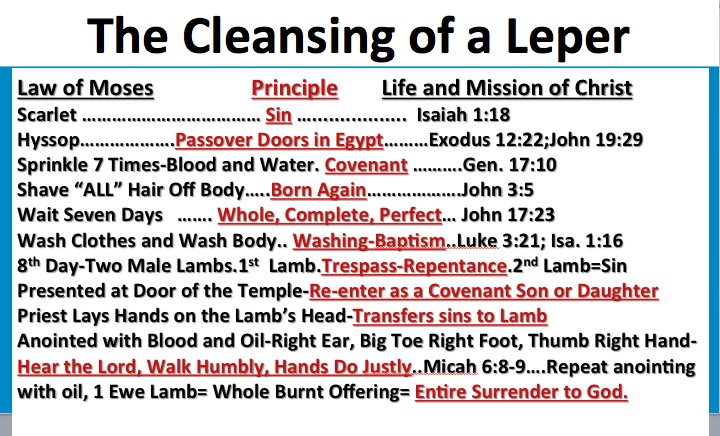
A single Levite Priest was required to meet with the potential leper and declare him clean or unclean. After identifying leprosy, the leper was required to “rend his clothes,” “bare his head,” “cover his upper lip,” and cry out in Aramaic, “Tema, Tema,” meaning unclean, unclean (Lev. 13:45). “He shall dwell alone [apart]; without the camp shall his habitation be. (Lev. 13:46).
Leprosy was seen as a punishment for sin.[6] The leper was separated from the presence of his loved ones, even as the sinner is separated from the presence of God. The leper was dead to his family and friends. “While thus excluded the leper was to wear [a] mourning costume [and] rend his clothes.”[7] The Prophet Joel pointed out that one was to rend his heart as a true sign of contrition more than just rending one’s garment (Joel 2:13). A bare head was a sign of “mourning” and “humiliation (Deut. 21:12.)[8] Covering the upper lip was a sign of being unclean (Isaiah 6:5). “Rending” the clothes symbolized grief and mourning. The Leper was spiritually dead and symbolically mourned his own death by the rending of his clothes. The only others required to rend their garments were witnesses to blasphemy or murder as a testimony that they did not agree with the murder or blasphemer.[9]
It was foreseen by the prophets that the Messiah would be treated as a leper. He would be rejected of men and had to dwell outside the socially accepted camp of Israel. The very Savior who would conquer death and sin and bring reconciliation between man and God was cast out of the Camp of Israel. Isaiah’s description of the Messiah’s reception among the people of Israel was similar to how the people viewed a leper:
There is no beauty that we should desire him. He is despised and rejected of men; a man of sorrows, and acquainted with grief: and we hid as it were our faces from him; he was despised and we esteemed him not (Isaiah 53:2‑3 and Mosiah 14:2-3).
The ceremony of cleansing the leper is quite touching when understood as being reconciled to God and loved ones through the Atonement. As sinners all mankind were spiritual lepers and banished from the presence of God. The leper will be ultimately pronounced clean through the sacrifice of the lambs and allowed to re-enter the congregation of the righteous.
The cleaning ceremony began outside of the camp of Israel or outside of the village or city (Lev. 14:3). In the mouth of two witnesses was truth to be established (Deut. 19:15). In John 5:32‑36, Jesus said the two witnesses to his Messiahship were John the Baptist and Heavenly Father.
It only took one priest to banish a leper, but it required two priest to testify that a leper was cleansed. (Deut. 17:6, Matt. 18:16). After the two priests had examined the skin of the leper and if the priests determined the leprosy was gone, they instructed the person to separate from the other lepers. As outcasts, lepers often lived in caves on the outskirts of town together and traveled together. Recall Jesus and the ten lepers that were traveling together when Jesus healed all ten and only one returned to thank him. Jesus instructed them to go and show themselves unto the priests (Luke 17:11‑19).
The symbolism of the Law of Moses was intended to be an important reminder of God’s Son. The priests brought to the cleansing ceremony “two birds alive and clean, and cedar wood, and scarlet, and hyssop… (Lev. 14:4).” The blood of the one bird that was sacrificed represented the blood of Christ’s Atonement. The cedar stick was used as the handle of a brush around which was tied the hyssop with a scarlet thread. The cedar was representative of the temple, as in the cedars of Lebanon that were provided by Hiram of Tyre to Solomon for the building of the temple (2 Sam 5:11).[10] Scarlet was representative of sin. Isaiah’s statement “though your sins be as scarlet” demonstrates the connection. It was hyssop that was used to put the Lamb’s blood on the two side posts and lintels of the “Passover Doors” in Egypt (Exodus 12:22). In Psalms, David pleads, “Purge me with hyssop and I shall be clean (Psalms 51:7). It was upon a hyssop stem that Jesus was offered a sponge of vinegar during his last minutes on the cross[11] (John 19:28).
Living water had to be running water or water poured from one vessel to another. The priest took two earthen pots from which water was poured from one pot into the other. One of the birds that was washed in “living water” and then sacrificed with the blood of that bird mingling with the water in one of the pots. Jesus was identified by Jeremiah as the forsaken “fountain of living water” (Jerimiah 2:13, John 4:10). When the Roman soldier pierced the side of Jesus on the cross, “blood and water” came forth (John 19:34).
All animals sacrificed under the Law of Moses had to be “kosher killed” so that the animal did not suffer. If the animal suffered, it was not acceptable as a sacrifice. “Behold, I, God, have suffered these things for all that they might not suffer” (D&C 19:16). Romans and Greeks typically strangled the animals which they offered up to their pagan gods. Converts to Christianity were strictly forbidden from eating “meats offered to idols, and from things strangled” (Acts 15:29).
The priest would dip the brush of cedar, scarlet, and hyssop into the blood and water and sprinkle it seven times upon the leper. Seven is a number that represented “whole, complete, and perfect.” With each sprinkle the priest would say, “Thou art clean.” It was at this point that the living bird would be dipped into the blood and water and then released in the field. The freed bird “symbolized the carrying away of the leper’s uncleanness” or sins.[12] The leper then would stay outside the camp for seven more days.
The cleansed leper was to wash his clothes, wash his body, and remove all the hair from the body. The washing of the clothes and body were symbolic of being clean. The removal of “all the hair” from the body had a practical health function, but more importantly removing all the hair from the body was spiritually symbolic of being born again, a new born without sin and prepared to be readmitted into the camp of Israel. On the eighth day the returning new born was to be presented by the priests at the “door of the Tabernacle” or temple with two male lambs without blemish. One male lamb was offered as a “guilt” offering and the other male lamb as a “sin” offering. The priest laid his hands on the head of the lamb and “transferred to the victim [lamb]”[13] the sins of the leper, even as Christ, as the Lamb of God, had the sins of all mankind transferred to himself.
Among the final cleansing scenes of the leper was their re‑consecration as a covenant son or daughter of God. The priest took some of the blood of the “guilt offering” and put it on the right ear lobe, on the thumb of the right hand, on the big toe of the right foot, and upon the head of the one being consecrated. This ceremony was repeated with olive oil. The symbolism suggested that they would listen to God, extend their hand in righteousness, walk in the paths of truth, and be completely committed to keeping the commandments of God. What did the Lord expect of a cleansed leper? The words of the Prophet Micah ring out
Wherewith shall I come before the Lord, and bow myself before the high God? Shall I come before him with burnt offerings, with calves of a year old?
Will the Lord be pleased with thousands of rams, or with then thousands of rivers of oil? Shall I give my firstborn for my transgression the fruit of my body for the sin of my soul?
He hath shewed thee, O man, what is good; and what doth the Lord require of thee, but to do justly, and to love mercy, and to walk humbly with thy God? (Micah 6:6‑8).[14]
“And the priest shall make an atonement for him before the Lord” (Lev. 14:18). The washed, anointed, and consecrated cured leper was then prepared to be presented to the Lord and enter into the congregation of the righteous.
It would be difficult not to see the obvious relationship between the healing of a leper and the life and missions of Jesus Christ. It was the entire intent of the Law of Moses to focus the chosen people of the Lord who were living under this law on their coming Atonement-Centered, Example-Centered Messiah.
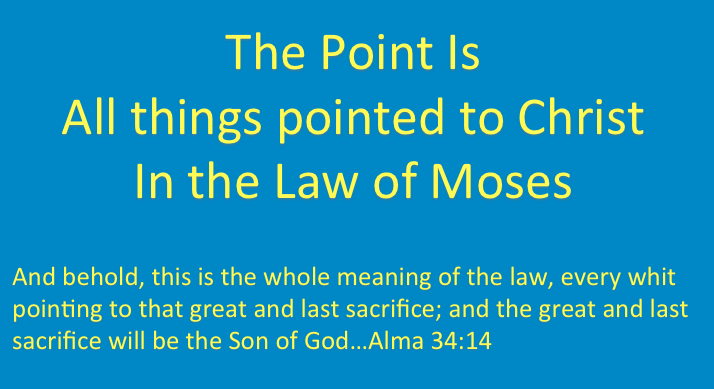
How the Law of Moses was Different from All Other Dispensations

The Father’s work and glory is to bring about the redemption of his children. The key element in the Father’s plan is the Atonement and exemplary dual mission of his beloved son, Jesus Christ. The single purpose of the Atonement according to the Prophet Joseph Smith was “the bringing men back into the presence of the King of heaven.”[15] In conjunction with this objective Joseph taught that the Father put Jesus in charge of the earth. In turn, Jesus gave Adam “dominion” over the seven dispensations of the gospel (Moses 2:28).
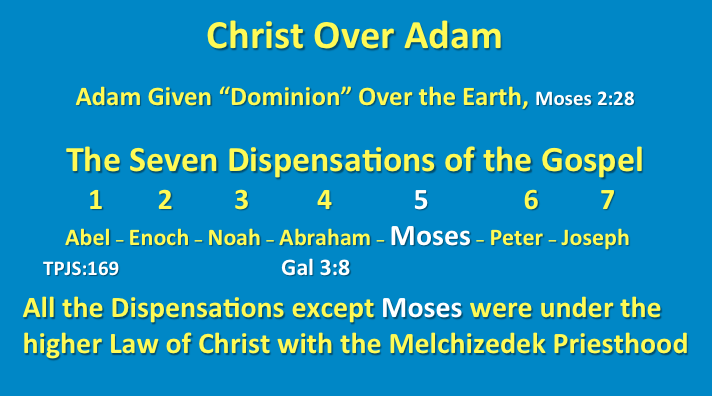

Joseph also taught that Abel was over the first dispensation and in spite of being killed by Cain was resurrected and “holding still the keys of his dispensation.” (TPJS, p. 169.) The other dispensations included Enoch, Noah, Abraham, Moses, Peter, and Joseph Smith. It is important to note that the Law of Christ and the Gospel was given to each of the dispensations. Paul pointed out that Abraham was taught the Gospel (Gal. 3:8). However, it was only the dispensation of Moses that had the Law of Christ withdrawn from them.

Strategic Retreat
Because the children of Israel were unprepared to live the higher law, the Lord gave the dispensation of Moses a lesser law. The Father’s love dictated that he strategically retreat to a law that the children of Israel could live and still bring about their eventual salvation.
When Moses came down from Mount Sinai the first time he had the complete Gospel, even the fullness of the Gospel (D&C 84:23‑27). However, Moses threw down the first set of tablets, which contained the fullness of the “Law of Christ” and returned to the top of Mount Sinai to receive a lesser law that the people could live. The lesser law is referred to as the Law of Moses.
Hew thee two tables of stone like unto the first ... which thou breakest, save the words of the everlasting covenant of the holy priesthood, and thou shalt make thee an ark of wood (Deut. 10:2 JST).
The higher ordinances of the Gospel were removed when the Lord found that the people of Israel, influenced by the traditions of Egypt, were unable and unprepared to keep the commandments associated with the greater Priesthood.[16]
After the resurrection of Jesus, neither the Christians in the Old World nor the Christians in the New World among the peoples in the Book of Mormon abandoned every element found in the Law of Moses. They only discontinued certain performances and ordinances related to animal sacrifice. The parts of the Law of Moses that were abandoned were those related to the shedding of blood. For example, the shedding of blood relating to circumcising all males was not required after the resurrection of Christ. The Apostle Peter and the Council of Jerusalem set forth the rules for both Jews and Gentiles that discipleship to Jesus required that they abstain from eating meat offered to idol gods, from drinking of animal blood offered to idol gods, and to abstain from fornication which was a part of idol worship among the Greeks and Romans of their time (Acts 15). New Christians were not required to be circumcised because Christ had fulfilled the shedding of blood requirement through the shedding of his own blood in the Garden of Gethsemane and on the cross. The same was true of all ordinances or commandments relating to the shedding of the actual blood of an animal. Jesus was the Lamb of God, the Messiah, and it was the blood of Jesus that fulfilled “every jot or tittle” of the Law of Moses (Matt 5:18, Alma 34:13, 3 Nephi 1:25, 3 Nephi 12:18). The sacrifice of Jesus was to be remembered by the institution and ordinance of the Sacrament. Bread was partaken to remember the body of Christ and wine was taken to remember the shed blood of Jesus.
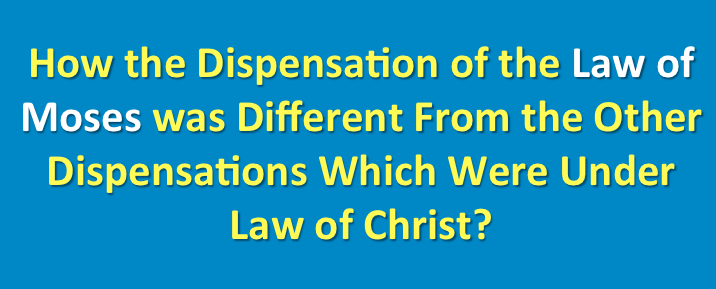
The Law of Moses: a Glass Half Full

The Law of Christ Filled the Glass to the Top
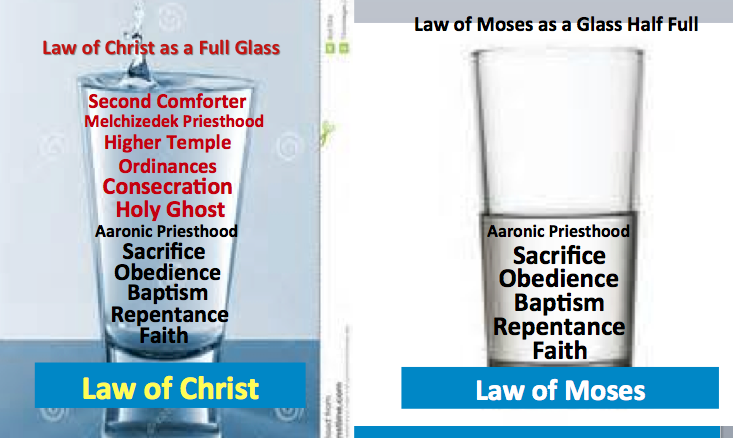
The Law of Moses embraced loving God with all of one’s heart, might, mind and strength (Deut. 6:5) and loving thy neighbor as thyself (Lev. 19:18). The Law of Christ was a “new commandment” for those previously under the Law of Moses and for all future disciples. The “new commandment” (John 13:34) required the love of God with all of one’s heart, mind, might and strength, but added a higher love of fellowman and of Heavenly Father. Jesus would say that it is not enough to love your fellowman as you would want to be loved. The “new commandment” required disciples to love each other as Christ loved.
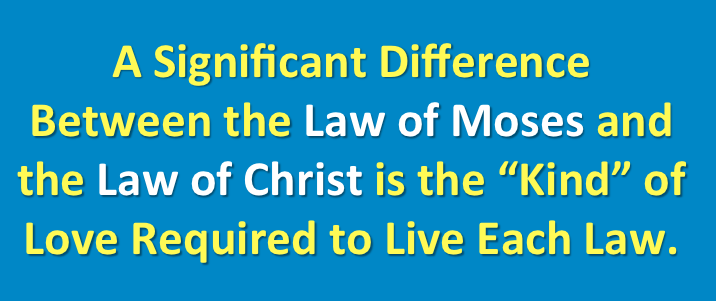
The pure love of Christ is charity (Moroni 7:47). The Greek word for charity is “agapé.” “Greater love hath no man” (John 15:13) is “agapé.” The Hebrew word used in Leviticus is “aheb” which means affection and is more or less equivalent to the Greek word “philos,” meaning friend or brotherly affection. In the Greek New Testament Jesus asked Peter twice, “’Agapé’ thou me and Peter responded that he did “philos” the Savior. The third time Jesus asked Peter, “’Philos’ thou me” and it grieved Peter. This event took place after the Lord’s resurrection on the shores of the Sea of Galilee, when Jesus instructed Peter to “feed my sheep” (John 21:15‑17).
Christians, both in the New World and in the Old World still kept the Ten Commandments. Many parts of the Law of Moses were retained as a part of Christian belief. The law of witnesses by the mouth of two or three witnesses (Deut. 19:15), capital punishment for certain crimes (Genesis 9:6), and a host of other commandments related to the Law of Moses were retained. The Law of Moses included the principles of obedience and sacrifice, faith in the Messiah, repentance, washings (Isaiah 1:14‑18), and the baptism of John the Baptist (D&C84:27). These ordinances were administered as a part of the lesser Priesthood or Levitical Priesthood also called the Priesthood of Aaron. However, these were all incorporated in the greater Gospel.
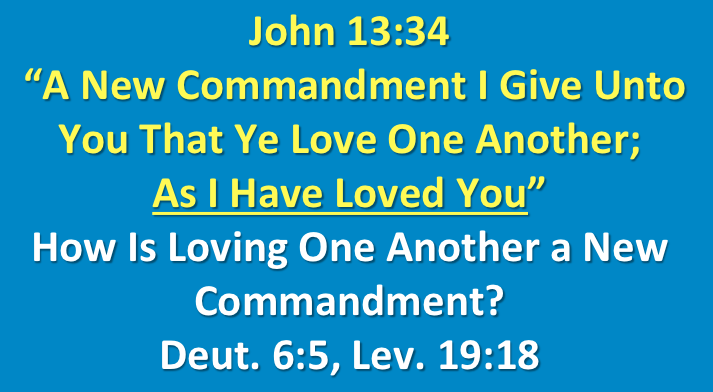
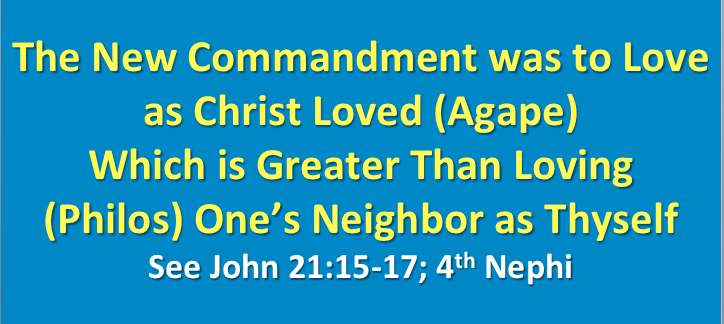
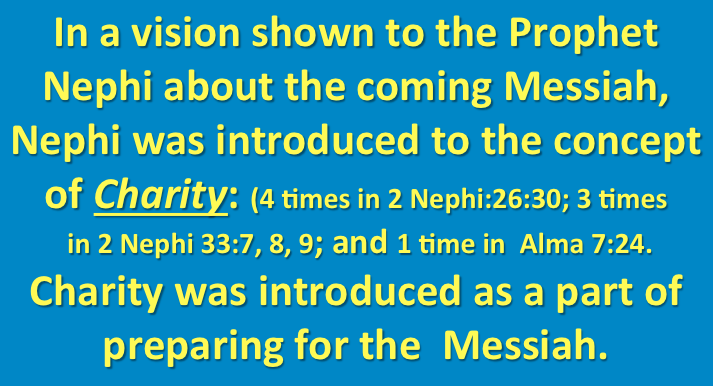
The Law of Christ restored the parts of the Law originally given to Moses on the first set of stone tablets. It should be remembered that the higher ordinances of the Gospel had been revealed through prophets in all seven dispensations. Adam was given dominion over this earth (Moses 2:28). Abel was appointed under Adam to be the head of the First Dispensation of the Gospel. The Prophet Joseph taught that Abel was holding still the keys of the First Dispensation.[17] The other dispensational heads included Enoch, Noah, Abraham, Moses, Peter, and Joseph Smith. The Millennial Dispensation will be ushered in and ruled over by Jesus Christ after his Second Coming. It was only the Dispensation of Moses that was denied the higher ordinances of the Gospel.
What Happened?
Why Didn’t the Jews Accept Jesus as the Messiah?
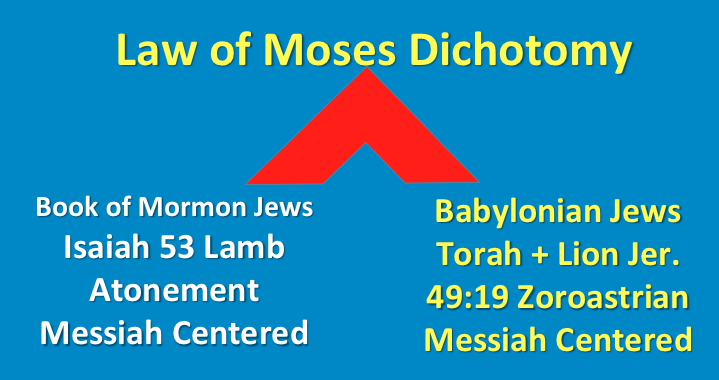
Historically, the Lord has called prophets and sent them among the “chosen people” to call them to repentance and refocus them on being examples of those who kept the commandments of God. In accomplishing the task of calling the people to repentance, the prophets warned the people that there were consequences for being disobedient. Chosen people were not chosen because God loved them and didn’t love the rest of his children. Quite the opposite. It is because of God’s love for all of his children that he “selects, calls, and chooses” a people to serve Him and to be instruments in God’s hands to serve and bless the lives of God’s other children. In Abraham all nations were to be blessed, even “all families of the earth” (Gen. 12:3).
What happens when the chosen people kill the prophets and ignore their calling as the “chosen people?” The Lord’s first call is to bless his obedient children. The first fourteen verses of Deuteronomy 28 are all about the “blessings” that will be poured out upon the obedient. Verse fifteen begins with these words,
But it shall come to pass, if thou wilt not hearken unto the voice of the Lord thy God, to observe to do all his commandments and his statutes which I command thee this day; that all these curses shall come upon thee, and overtake thee… (Deut. 28:15).
For the next fifty‑three verses the curses of God are unfolded and they become progressively worse. When the chosen people become ripe in iniquity, and by definition that means they are past feeling the light of conscience, past listening to witnesses of the Holy Ghost, or hearing the words of the prophets, they are left to their own demise. “It is by the wicked that the wicked are punished” (Mormon 4:5). The faithful are promised that their enemies “shall come out against thee one way, and flee before thee seven ways” (Deut. 28:8). However, the unfaithful were promised that they would be smitten by their enemies: “thou shalt go out one way against them, and flee seven ways before them” (Deut. 28:25). The ultimate curse is the destruction of the chosen nation and the delivering of the chosen people to the gentiles in a “military might” makes right society.
The chosen people divided into two nations after the death of King Solomon. The northern kingdom became known as Israel and the southern kingdom took the name the Kingdom of Judah. The northern kingdom fell into apostasy first and eventually around 722 BC were carried away captive to Assyria. They became known as the lost Ten Tribes of Israel. They have been scattered abroad throughout the earth. Isaiah said, “O Assyrian, the rod of mine anger, and the staff in their hand is mine indignation ... shall the axe boast itself against him that heweth therewith?” (Isaiah 10:5, 15.) It was the Lord that withdrew the protections that obedience brings that allowed Assyria to conquer Israel.
The southern Kingdom of Judah fell into the same apostasy that the nation of Israel did and the consequences were the same. After Babylon’s victory over Pharaoh Necho II at the battle of Carchemish in 605 BC, the downfall of apostate Judah was only a matter of time. The period known as Judah’s “Babylonian Captivity or Exile” can be broken into three parts even though historians disagree on the exact dates:
There were in fact three separate years when people from Jerusalem were taken into exile:
1. 605 BC – This is when Daniel and other members of Judah’s elite were taken into captivity (see Daniel 1:1‑6).
2. 597 BC – Jehoiakim was taken into captivity (see 2 Chron. 36:5‑6). Three months and ten days later his son, Jehoiachin, along with other members of the royal family were taken into captivity, and the craftsmen and smiths, and the men of might that were strong for war (see 2 Chron. 36:9‑10 & 2 Kings 24:15‑17).
3. 586 BC – After a siege of one and a half years, Jerusalem was conquered and destroyed. Most of the people were taken into captivity, along with articles from the temple. Only the poorest people remained (see 2 Kings 25).[18]
The Book of Mormon story begins within the historical backdrop of the Babylonian domination of the Holy Land. Lehi was called as a Prophet and given a vision of the imminent destruction of Jerusalem and of the Babylonian captivity. Lehi taught and “manifested plainly of the coming of a Messiah and also the redemption of the world.” (1 Nephi 1:19). Lehi received a revelation in 600 BC to flee from the impending destruction of Judah. When Lehi and his family left Jerusalem, they took with them the scriptures up to and including many of the writings of the Prophet Jeremiah (1 Nephi 5:11‑13). Equally important is that Lehi and his family took with them the Atonement-Centered Messiah as the Lamb of God that the Law of Moses was intended to convey.

The imagery of four animals symbolized the various aspects of the Messiah’s missions. In summary they were the Lamb (130 references to Christ as the Lamb including Isaiah 53:7). The Lamb of God was meant to convey meekness, humility, and obedience and encompassed doing the will of the Father through the Atonement. The Messiah as an Eagle (Deut.32:11). Eagles were swift, powerful, and protective with healing in their wings (Mal.4:2). The Serpent as an image of Christ is difficult for Christians to accept because Lucifer’s encounter with Eve in the Garden of Eden, however Moses raised up a bronze serpent in the wilderness (Num.21:6-9) as a symbol of faith in Christ and Jesus would later say, “And as Moses lifted up the serpent in the wilderness, even so must the Son of man be lifted up” (John 3:14). Lastly, the Messiah is portrayed as the Lion of Judah (Gen.49:10, Rev.5:5). The Lion imagery is one of royalty, birthright, and destruction (Num.23:24).[19]
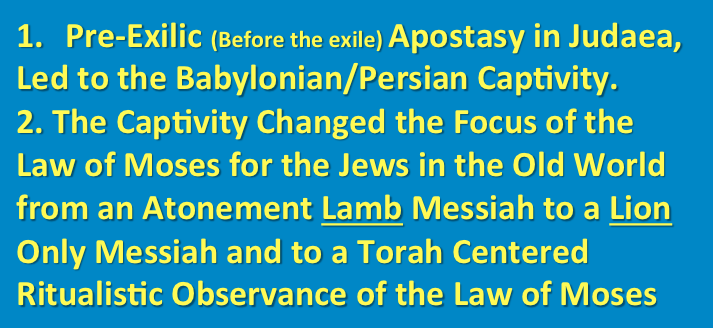
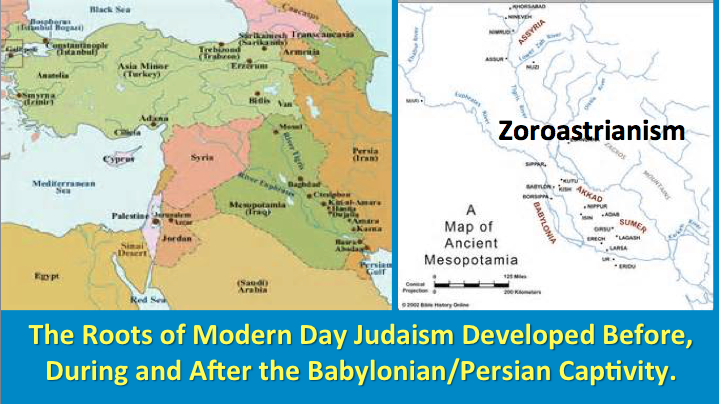
It is relevant to see how the mission and imagery of the Lamb of God with its focus on the Atonement was diminished and relegated to a minimal position during the Babylonian Captivity.
What Happened to the True Understanding of the Jewish “Lamb” Messiah
During the Babylonian Captivity?
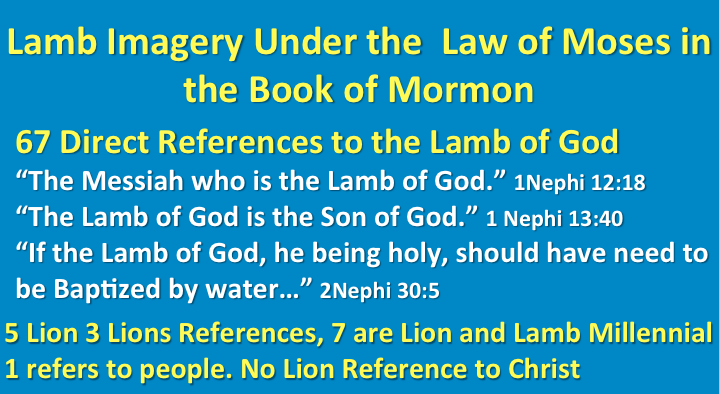
The answer to the question: “What Happened to the True Understanding of the Jewish “Lamb” Messiah?” is the Babylonian Captivity. The Pharisees and Sadducees in the time of Jesus had fallen away from the original pre-exilic (586 BC Babylonian captivity) observance of the Law of Moses as taught by the Prophets.
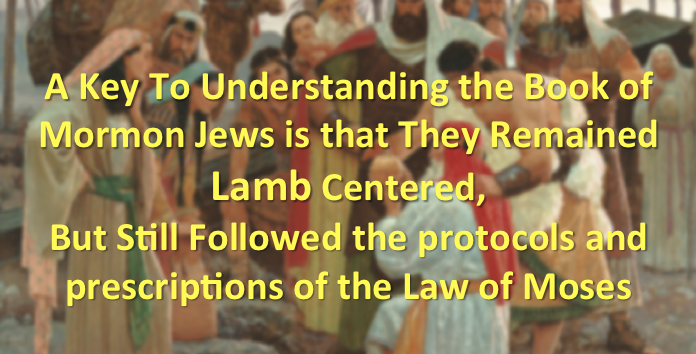
During the Babylonian Captivity a group of Jews separated themselves from many but not all of the heathen practices of the Babylonians. The royal cultural religion of Persia and much of the Mesopotamian region was Zoroastrianism. However, the Babylonians had a multitude of gods and goddesses much like the Greeks. Zoroastrianism was a part of that Babylonian mix. In some ways the Ahuramazda of Zoroastrianism was the closest to the Hebrew theology and therefore the most dangerous and easiest with which to identify. The separatists considered themselves elite, chief among men, special, and “preferred” by God. The Greek word Pharisee means “to separate and derives from the Hebrew with the same meaning.”[20] In their attempt to live upright lives they became extremely self-righteous and judgmental. They began “hedging” or “building hedges” around the Law of Moses. For example, one basic commandment was to “keep the Sabbath Day holy.” The Pharisees asked themselves, “How far could a person walk on the Sabbath Day and still keep the Sabbath Day holy?”
The limit set by the rabbis to the Sabbath day’s journey was 2,000 cubits from one’s house or domicile, which was derived the statement found in Joshua 3:4 that this was the distance between the ark [of the Covenant] and the people on their march, this being assumed to be the distance between the tents of the people and the tabernacle during the sojourn in the wilderness. Hence, it must have been allowable to travel thus far to attend the worship of the tabernacle.[21]
The Pharisees continued to add hedge after hedge after hedge to the commandments. This developed into an oral tradition called the “Mishnah” (a compendium of regulations attributed to about 150 rabbis who lived from about 50 BC to about AD 200). It was the Pharisees who survived the Babylonian Captivity that changed the Law of Moses into ritualistic observance based on oral tradition. These oral traditions would eventually evolve into 613 commandments.[22] In Hebrew, (הדיברות תורה), means Torah Commandments or the commandments given to Moses which are recorded in the first five books of the Bible: Genesis, Exodus, Leviticus, Numbers, and Deuteronomy. The Torah, the Pentateuch, and the Law of Moses are all synonyms for these books. What Christians refer to as the Old Testament was referred to by Jesus as the Law, the Prophets and the Psalms when he announced to his disciples
That all things must be fulfilled, which were written in the law of Moses, and in the prophets, and in the psalms, concerning me. (Luke 24:44).
The Pharisees interpreted and reinterpreted these laws into “approved of” and “not approved of” behaviors that left little or no room for exceptions or the Spirit.
In spite of their most ardent protestations and desire to separate themselves from the influence of Babylon, there were many subtle Babylonian and Zoroastrianisms that crept into the religious lives of the Babylonian/Persian Jews. Foremost among the obvious things adopted by the Babylonian Jews was the Babylonian Calendar and the Babylonian names for the Jewish months. It was during the Babylonian Captivity that the Jews accepted the solar vernal equinox of March 21/22 as the date to correct their lunar calendar and to determine the dates for the Passover, spring, and other holy days.

Saoshyant, the Zoroastrian Messiah

There was an even more subtle influence that had an infinitely more devastating effect upon the future of Judaism. It was the integration of the Zoroastrian-like Messiah “Saoshyant.” “It is believed that the Jewish idea of the Messiah is derived from the earlier Zoroastrian notion of the Saoshyant.”[23] Like the religions of Christianity, Islam, and Judaism, Zoroastrianism believed in a future coming of a Messiah. Most concepts of a Messiah figure included the idea of a “political savior.” The Messiah of the Law, the Prophets, and the Psalms was more than a political savior to be worshipped as a world-conquering “Lion” figure. The Messiah of Isaiah 53 and multiple images in the scriptures was of a sacrificial lamb who was a spiritual Savior who has borne our griefs and carried our sorrows … he was wounded for our transgressions, he was bruised for our iniquities … he was oppressed, and he was afflicted … he is brought as a lamb to the slaughter, as a sheep ... (Isaiah 53:4‑7, Mosiah 14:4‑7).
When the promised Messiah appeared among the Babylonian influenced Jews in Judaea, some five hundred and fifty years later they were blinded by the expectations for a political savior like the Zoroastrian Saoshyant, who would deliver them from the “Pax Romana.”
Unlike the single mission of a lion-like political savior, the Atonement-Centered, Example-Centered Messiah of the Law of Moses, the Prophets and the Psalms had a dual mission to come as a Lion and as a Lamb. Jesus would come first as the sacrificial “Lamb” and later as the “Lion” of the tribe of Judah. The Lion imagery as one who destroy the political empires of the world is a valid scriptural expectation.
There shall come a Star out of Jacob, and a Sceptre shall rise out of Israel, and shall smite the corners of Moab … Edom … Amalek …Kenites … Alas, who shall live when God doeth this! (Numbers 24:17‑23.)
It is interesting to note that even the apostles of Jesus were unaware of a second coming of the Messiah. “Then understood his disciples that he should come again on the earth, after that he was glorified and crowned on the right hand of God.” (JS‑Matthew 1:1). His disciples were typical of the Jews in Jesus’ day. Several Bible scholars argue that Judas betrayed Jesus because he failed to meet the requirements of the Lion prototype of the Jewish Messiah.
Because of the maze of additional Pharisaical requirements that were imposed upon the laws given to Moses, and a diminished understanding of the Messiah, the Judeans failed to recognize the very being who had given them the Law of Moses, even Jesus, the Lamb of God, who would return as the Lion.[24] The teaching of Jesus sounded strange because of the lost knowledge of the Lamb Messiah who would bring love, mercy, and “arise with healing in his wings.” (Malachi 4:2).
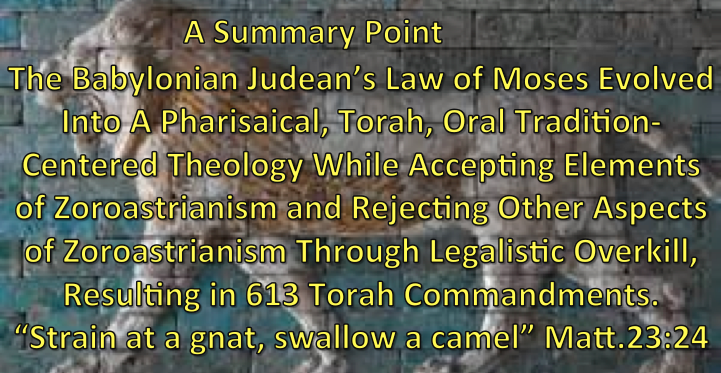
Eventually, one could not heal or be healed on the Sabbath Day without offending the governing body of the Jews known as the Sanhedrin.
The man departed, and told the Jews [Sanhedrin] that it was Jesus, which had made him whole. And therefore did the Jews persecute Jesus, and sought to slay him, because he had done these things on the Sabbath day. But Jesus answered them, My Father worketh hitherto, and I work. Therefore the Jews sought the more to kill him. (John 5:15‑18.)
The harshest words spoken by Jesus were in reference to the Pharisees and Sadducees who had perverted and changed the original laws given to Moses into a legalistic nightmare. The Savior called the Pharisees and Sadducees “hypocrites” and “blind guides” because they had “omitted the weightier matters of the law, judgment, mercy, and faith” (Matthew 23:23).[25]
When Christians think about the Law of Moses they often reflect upon the New Testament portrayal of the Pharisees and Sadducees. This perspective frequently result in a negative attitude towards the Law of Moses. The Lord was not opposed to the Law of Moses. He gave it. Jesus came to fulfill the Law: “Think not that I am come to destroy the law, or the prophets: I am not come to destroy, but to fulfill ... one jot or tittle shall in no wise pass from the law, till all be fulfilled” (Matthew 5:17‑18). It was the apostate form of the Law of Moses to which Jesus objected. Most of the objections of Jesus can be traced to the Babylonian influence.
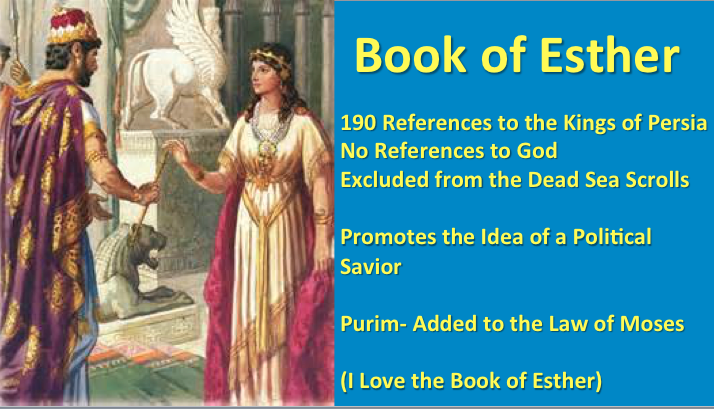
The Book of Esther celebrates the political survival of the Jews and reinforced the notion of a political savior. Most scholars place the writing of Esther to the Hellenistic Period of Judah and just prior to the Maccabean Period (167-135 BC.)[26] The Book of Esther is one of the most controversial books of the entire Bible because the Persian king is mentioned 190 times, but the name of the God of Abraham, Isaac and Jacob is not found. Esther does not mention any of the Jewish customs, prayers or dietary regulations. Esther seems to follow more closely with the teachings of Zarathustra than any of other Biblical documents. After all, the Father-in-law of Esther was Darius, a follower of Zarathustra as was her husband Xerxes.[27] This may also be the reason that the Essenes along the shores of the Dead Sea chose to copy all the books of the Old Testament except the Book of Esther in the Dead Sea Scrolls. The point being that the festival of “Purim” which celebrates the Book of Esther was added to the Law of Moses as one of the holy day celebrations. But what purpose did it truly serve? It reinforced the notion that the political salvation of the Jews was paramount and not the spiritual salvation of their souls.[28] Nevertheless the true message of Esther may be that the Jews abiding in Esther’s Persia were saved from extinction but they were not saved from the Zoroastrianism which infiltrated those who returned to Jerusalem.
A Correct Understanding of the Book of Mormon Observance of the Law of Moses
Compared to the Babylonian Influenced Judaic Observance
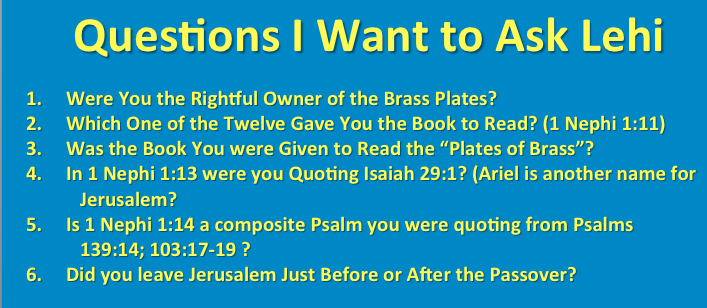
Lehi left Jerusalem before the Babylonian Captivity. Written on the plates of brass, which were in his possession, were the commandments given to Moses. Nephi acknowledged, “I also thought that they could not keep the commandments of the Lord according to the Law of Moses, save they should have the law. And I also knew the law was engraven upon the plates of brass” (1 Nephi 4:15‑16). Lehi and his band of exiled Judeans lived the Law of Moses untainted by the separatist Pharisees and their oral traditions. This does not mean there is no value in the oral tradition. It means that if there is a conflict between the Book of Mormon and the oral tradition of the Babylonian Jews, the Book of Mormon prophets “trump” the traditions of the rabbis as a more reliable source. There are many good and well-meaning people “who are only kept from the truth because they know not where to find it. (D&C 123:12) And there are others who have been overwhelmed by the “tradition of their fathers.” (D&C 93:39).
All pre‑exilic Jews did not agree with Lehi. Many were in a state of apostasy, including two of his own sons, Laman and Lemuel. The Lord’s calling of Lehi to the role of a prophet, like unto Jeremiah, Ezekiel, and Isaiah increases his reliability as a legitimate source of how to keep the Law of Moses and a correct understanding of the Atonement-Centered Messiah. Also the provenance of the Book of Mormon is unquestionably more reliable because the records were kept by prophet-historians in the first person (“I Nephi…”) and they were approved of and preserved by the Lord without oral tradition and a multitude of rabbis.
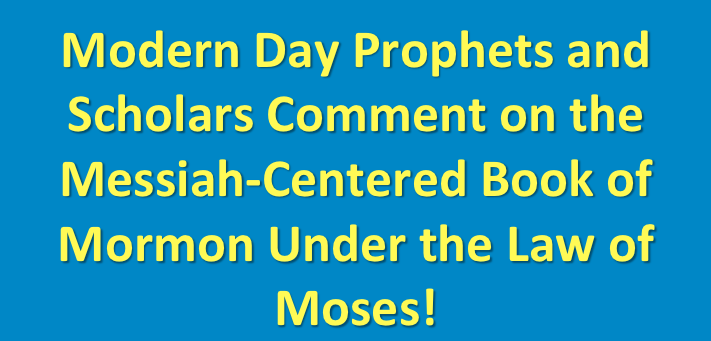
As President John Taylor observed:
It appears indubitable from the two records, the Bible and the Book of Mormon, that the intent and true meaning of the law of Moses, of its sacrifices, etc., were far better understood and comprehended by the Nephites than by the Jews.[29]
Neal A. Maxwell wrote, “The Book of Mormon peoples, though Christians, were tied much more strictly to the pre-exilic Law of Moses until Jesus came than we in the Church have fully appreciated.”[30]
Elder Jeffrey R. Holland insisted that “It is important to understand that for six hundred years the descendant of Lehi observed the Law of Moses.”[31]
Scholars of the Book of Mormon like Hugh Nibley, John W. Welch, Gary P. Gillum, and Don E. Norton have all supported the fact that the prophet-historians of the Book of Mormon kept “the Law of Moses but in everything anticipate[d] the coming of the Messiah and the New Covenant.”[32]
Stephens Ricks and William Hamblin agreed, “The Nephites observed the law of Moses in all respects, including its requirements and proscriptions.”[33]
Paul Chessman, in his early research in the Book of Mormon, noted that the Book of Mormon prophets “observed the moral injunctions and ritual aspects of the law of Moses.”[34]
Susan Easton Black concurred, “While they kept the law of Moses, they looked forward with steadfastness to Christ.”[35]
Monte Nyman and Charles Tate wrote, The Book of Mormon confirms the fact that the Nephites lived the Law of Moses until Jesus said it was fulfilled when he visited them after his resurrection in Jerusalem.”[36]
B.H. Roberts recognized that the Nephites offered “sacrifices and administer[ed] in the other ordinances of the law of Moses which the Nephites were commanded to observe.”[37]
Orson Pratt told the early Latter‑day Saints that those in the Book of Mormon, “Worshipped according to the law of Moses until they were taught and received the Gospel.”[38] On another occasion Orson Pratt was more specific:
They, having kept the law of Moses, I mean the Nephites, looked forward according to the testimony of their law, for the coming of the Messiah, that is the great Prophet of Israel which Moses had told them the Lord would raise up unto them. They looked for that great Prophet to come and shed his blood for their sacrifices and burnt offerings pointed to a great and last sacrifice, the sacrifice of the Son of God. The Nephite nation, therefore, had a testimony given to them concerning that future Messiah that was to come...[39]
Summarizing the scholars, Spencer J. Condie said, “All of the Book of Mormon prophets prior to the coming of Christ taught the law of Moses.”[40]

As clear as these scholars have been, there is no substitute for the words of the Book of Mormon itself. In the year 570 BC Nephi declared in 2 Nephi 5:10,
And we did observe to keep the judgments, and the statutes, and the commandments of the Lord in all things, according to the law of Moses.
The phrase “in all things” is very comprehensive and inclusive. As the following list of scriptures will reinforce, the pre‑exilic Law of Moses was taught and lived by the prophet-historians of the Book of Mormon. Around 550 BC Nephi again said,
“We keep the law of Moses … until the law shall be fulfilled … Yet we keep the law … And, inasmuch as it shall be expedient, ye must keep the performances and ordinances of God until the law shall be fulfilled which was given unto Moses.” (2 Nephi 25:24‑25, 30.)
Nephi’s brother, Jacob, declared after the death of Nephi, “We keep the law of Moses … until the law shall be fulfilled … Yet we keep the law.” (Jacob 4:5.)
Two hundred years after Lehi left Jerusalem in 400 BC, the Prophet Jarom declared in solemn terms,
And now, behold, two hundred years had passed away, and the people of Nephi had waxed strong in the land. They observed to keep the law of Moses and the Sabbath day holy unto the Lord. And they profaned not; neither did they blaspheme … exhorting with all long‑suffering the people to diligence; teaching the law of Moses and the intent for which it was given; persuading them to look forward unto the Messiah, and believe in him to come... (Jarom 1:5, 11.)
In the year 124 BC Mosiah pointed out how extensively the Nephites were keeping the Law of Moses:
And they also took of the firstlings of their flocks, that they might offer sacrifice and burnt offerings according to the law of Moses… (Mosiah 2:3).

Other statements in the Book of Mosiah record,
…He [the Lord God] appointed unto them a law, even the law of Moses. (Mosiah 3:14.)
King Mosiah did walk in the ways of the Lord, and did observe his judgments and his statutes, and did keep his commandments [in the law of Moses] in all things … (Mosiah 6:6).
And they said: We teach the law of Moses. And again he said unto them: If ye teach the law of Moses why do ye not keep it? … And what know ye concerning the law of Moses? (Mosiah 12:28‑31.)
I say unto you that it is expedient that ye should keep the law of Moses as yet; … (Mosiah 13:27).
Therefore, if ye teach the law of Moses, also teach that it is a shadow of those things which are to come—(Mosiah 16:14).
In circa 80 BC the Book of Alma reported,
They did walk in the ways of the Lord, and did observe to keep his commandments and statutes. Yea, and they did keep the law of Moses; for it was expedient that they should keep the law of Moses … they did look forward to the coming of Christ, considering that the law of Moses was a type of his coming… (Alma 25:14‑15).
In 74 BC Alma announced that
They were strict in observing the ordinances of God, according to the law of Moses; for they were taught to keep the law of Moses until it should be fulfilled (Alma 30:3).
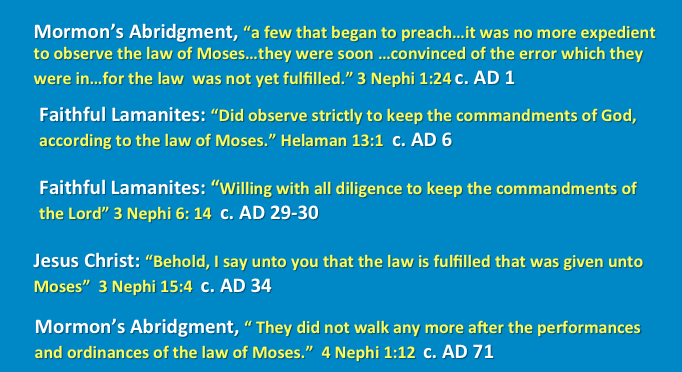
In the year of Christ’s birth, AD 1[41] Mormon’s abridgment included the following statement:
And there were no contentions; save it were a few that began to preach, endeavoring to prove by the scriptures that it was no more expedient to observe the law of Moses. Now in this thing they did err, having not understood the scriptures. But it came to pass that they soon became converted, and were convinced of the error which they were in, for it was made known unto them that the law was not yet fulfilled, and that it must be fulfilled in very whit; … (3 Nephi 1:24).
Faithful Lamanites were described in 6 BC and later in AD 29, before the resurrection of Jesus as follows:
… the Lamanites did observe strictly to keep the commandments of God, according to the law of Moses (Helaman 13:1).
… they do observe to keep his commandments and his statutes and his judgments according to the law of Moses (Helaman 15:5).
… the Lamanites who were converted unto the true faith; and they would not depart from it, for they were firm, and steadfast, and immovable, willing with all diligence to keep the commandments of the Lord [according to the laws of Moses] (3 Nephi 8:5).
In the 34th year “in the first month, on the fourth day of the month” (3 Nephi 8:5), the sign was given indication the death of Christ on the cross. This event would mark the end of the shedding of blood as a part of the Law of Moses. (Alma 34:13.)
Jesus Establishes the Gospel in the New World and Appears to Other Sheep
After the resurrection of Jesus Christ, he appeared to the inhabitants of the New World in America. There are more than fifty-five references in the traditions of the inhabitants of the western hemisphere of the “White Bearded God” who appeared to their ancestors and promised to return. Taylor Hanson, not a member of the LDS Church, recorded more than fifty appearances of the God who descended from Heaven among Native Americans in North, Central and South America and those in Polynesia.[42] I have also found, in my research, other cultures and traditions of the “Descending God” among the Lacandon Maya, the Arawak of the Caribbean, and others not mentioned by Taylor Hanson.[43] In Bolivia and Chile, the “Descending God” was called “Tunupa, Eqeqo, and Tarapaka.”[44] In Northern Peru he was known as Pariaqaqa and Pachakamak. In Ollantaytambo, Peru, he is also Tunupa.[45]
The Book of Mormon is the premier witness of the appearance of the “White Descending God” to the inhabitants of the Americas. During one of his many appearances to the descendants of Lehi and descendants of those of the other tribes of Israel, Jesus said,
Ye are they of whom I said: Other sheep I have which are not of this fold; them also I must bring, and they shall hear my voice; and there shall be one fold and one shepherd (3 Nephi 15:21).Behold, I say unto you that the law is fulfilled that was given unto Moses (AD 34) (3 Nephi 15:4).They did not walk any more after the performances and ordinances of the law of Moses. (AD 72) (4 Nephi 1:12).
Some Implications of the Law of Moses in the Book of Mormon

The prophet-historians of the Book of Mormon were diligent in keeping the Law of Moses “in all things” The question may be asked, “How does keeping the Law of Moses relate to the events in the Book of Mormon?” The answers are instructive.
What calendar was used in the Book of Mormon? The first of all the laws given to Moses was given in Exodus 12. It related to the Hebrew festival of the Passover and to the first month of the year. It defined the Hebrew calendar and the Book of Mormon calendar.
And the Lord spake unto Moses and Aaron in the land of Egypt, saying, This month shall be unto you the beginning of months: it shall be the first month of the year to you … And this day shall be unto you for a memorial; and ye shall keep it a feast to the Lord throughout your generations; ye shall keep it a feast by an ordinance forever (Exodus 12:1‑2, 14).

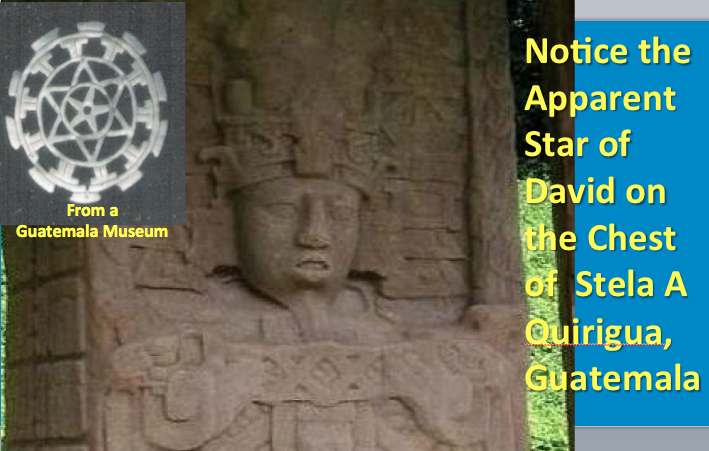
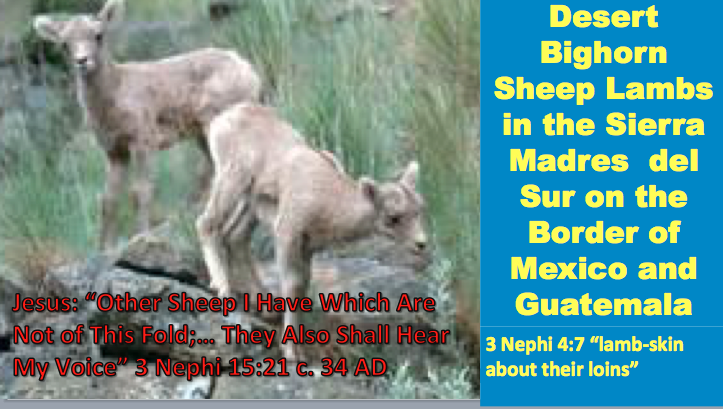
It would be absurd to assume that the Book of Mormon keepers of the Law of Moses “in all things: would not keep the feast of the Passover. It would be equally absurd to assume that a devout Christian would not observe Easter or the birth of Christ. The Passover occurred in the spring of the year in Egypt. The pre‑Babylonian Jews (587 BC) celebrated their lunar calendar by naming the months of the year by numbers (1 to 12) from the first to the twelfth month. Later, while in Babylon the Jews adopted Babylonian name for their calendar and they adopted the solar equinox of March 21st or 22nd as the beginning of spring. However, Lehi and his followers left Jerusalem before the Babylonian Captivity. Lehi’s migrants would not have known or used the Babylonian names for the Jewish months. They simply referred to them as the first month, second month, etc. From about 587 BC to 1830, a period of nearly 2,400 years, the months of the Jewish calendar were only known by their Babylonian names. It is highly doubtful that Joseph Smith, who published the Book of Mormon in 1830, was aware that the months of the Jewish calendar were known only by numbers and not by the Babylonian names when Lehi left Jerusalem.


All the months beginning with Nissan (pre-exilic name: one or Aviv meaning spring) have 29 and 30 days a month just like the Roman calendar. Often there is a short 13th month (Adar II) to adjust the lunar calendar so that the Passover is always held in the spring. The current Passover occurs between March 21 and April 25 of each year. The Jewish calendar is a lunar calendar, adjusted now by the solar equinox which occurs on the 21st or 22nd of March. The Passover is determined by the first Sabbath day after the new moon after March 21‑22. Under every circumstance, the Passover is celebrated in the spring.
Pre‑exilic Jews were paranoid that they might miss the celebration of the Passover in spring and used a number of indicators to make sure they would abide by the commandment in Exodus 12.[46] The birth of lambs in the spring, the first new moon after the blossoming of the almond trees in the springtime of the year, barley was planted in the autumn and ripened in spring. All of these signs were examined by the pre‑exilic Jews. “Lambing season in the Middle East occurs in early to mid‑March.”[47] The Passover had to be after lambing season or after early to mid‑March or March 15th or there would be no lambs to sacrifice and eat. The “lambing season” is directly relevant, like all mammals reproduction, to the time of mating. This only occurs naturally in the sheep world with the declining day light in the autumn. The gestation period of sheep is 147 days, +/- 5 days.
Unlike most other farm animals, sheep are seasonal breeders and lamb in the spring months when the weather is warming and supplies of grass are available.[48]
This means that the Book of Mormon reference to the first month of the year would be after March 15 and before April 25.[49] It turns out that the Babylonian Jews adoption of March 21st and March 22nd as the beginning of spring is a reasonable date. The Book of Mormon pre‑exilics would only be off a few days but still celebrated their first month in the spring. It is reasonable to believe that the Book of Mormon peoples were aware that the Mesoamericans identified the vernal equinox as March 20th and 21st and may very well have used the same date.[50] It is also true that there were several varieties of sheep in Mexico and Central America available for sacrifice.[51] The value of knowing when the first of the year occurs in the Book of Mormon is extremely important for a number of reasons.
For example, the Lamanites came to battle dressed only in a loincloth and their heads were shaven from 544 BC (Enos 1:20) to AD 21 (3 Nephi 4:7). It is difficult to believe that the Lamanites would come to battle naked except for a loincloth in a climate like Buffalo, New York, or Zarahemla, Iowa, that was not conducive to year-round nakedness. In Alma 16:1‑9, the Lamanites came to battle in the second month of the year and were driven back ten months later and thus ended the eleventh year of the reign of the judges. This means the battles and the war went through the winter months. In the commencement of the eighteenth year of the reign of the judges the Lamanites were coming to war. (Alma 43:3.) “They were naked, save it were a skin which was girded about their loins; yea all [Lamanites] were naked” (Alma 43:20). Some of these wars lasted for months and even years. One example of a war that lasted continuously for years was that between Amalickiah and Moroni. “Amalickiah did himself come down at the head of the Lamanites. And it was in the twenty and fifth year of the reign of the judges” (Alma 51:12). Amalickiah was killed by Teancum on the last day of the year twenty-five. On the first day of the first month of year twenty-six of the Book of Mormon reign of the judges Amalickiah was found dead (Alma 52:1.) This date equates to the first day of the new moon (near April 5, 66 BC or 14 Nisan 3695).[52] It is important to note that Amalickiah was tired because of his “labors and the heat of the day” (Alma 51:33). Where is there a climate on a seashore in North America where “the heat of the day” exists on April 4, or between March 21 and April 25 in 67 BC?[53] According to climate scientists, the North American continent was in a cooler cycle in 67 BC than it is today.[54]
In summary of the calendar issue, the Book of Mormon prophet-historians and the faithful kept the Law of Moses with all of its performances and commandments. The ramifications for students of Book of Mormon geography are significant. As keepers of the Law of Moses this means the first month of the year in the Book of Mormon would be in the spring between March 15 (pre‑exilic earliest possible time) and March 21 (post Babylonian) to April 25. This is the first month. It is always celebrated in the spring and has been since the Lord gave the commandment to Moses in Exodus 12:1‑2. The Book of Mormon identified the first month of the year as either the “commencement of the year,” or the first month. The specific references to the months named in the Book of Mormon include the first, second, sixth, seventh, tenth, and eleventh months.[55] The twelfth month was also referred to as “thus ended” the year. (Alma 51:37).[56]
Homicide, Murder, Justifiable Homicide

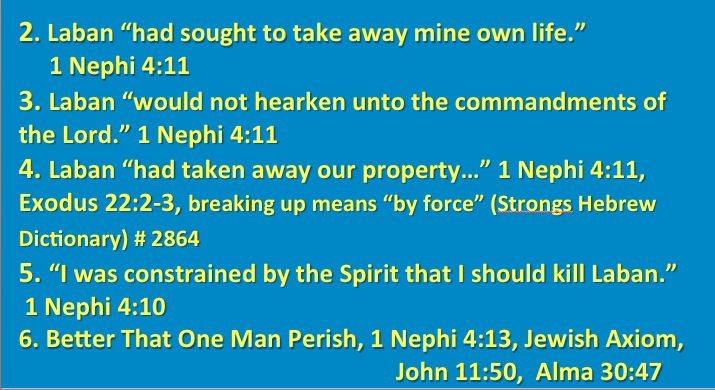
Some of the most obvious implications of the Law of Moses in the Book of Mormon relate to the legal requirements for the taking of a human life. An important insight into the deaths of Laban, Sherem, Korihor, and Zemnarihah relate to the Law of Moses. Many students of the Book of Mormon and those unfamiliar with the Law of Moses are uncomfortable with Nephi killing Laban. (1 Nephi 4:6‑18.) The historical issues surrounding the death penalty in the Bible deserve serious consideration and research in order to understand the Law of Moses. Some have expressed that it was hard for them to believe that a prophet of God would be commanded to kill any human being under any circumstance.[57] Most of those who have a difficult time with the Old Testament fall into a common historical trap of judging a former society by current social norms. This fact remains, Heavenly Father and his Son “doeth not anything save it be for the benefit of the world; for he loveth the world even that he layeth down his own life (2Nephi 26:24).
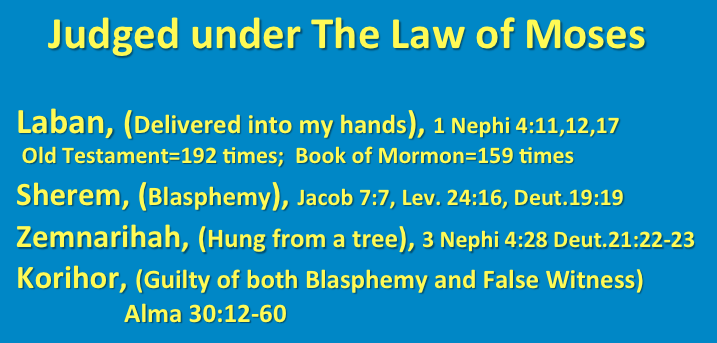
Certainly the most qualified researcher on this topic is lawyer and scholar, John W. Welch, and the many publications he has produced. His works will be cited and are a must read for those who want to delve deeper into these issues.[58]
The taking of human life has always been a matter of law from the time of Cain killing Abel. (Genesis 4:8‑9). The Lord had declared that “whoso sheddeth man’s blood, by man shall his blood be shed; …” (Genesis 9:6). Cain was aware of this law and said to the Lord, “Every one that findeth me shall slay me” (Genesis 4:14). In Cain’s case, the Lord chose to spare him for other purposes.
The Lord’s laws about homicide take into consideration the conditions under which the slayer killed the other human and the mental state and the intent of the slayer.[59] The Law of Moses divides homicide, or the killing of one person by another, into two categories: murder and justifiable homicide. Murder is the unlawful taking of human life. Justifiable homicide is the lawful taking of human life.
The King James translation of the Bible has added to the confusion of homicide. In translating the Hebrew into English, the King James scholars used the word “kill” instead of the Hebrew word “râtsach,” [ח צ ד] which means “murder,”[60] or the unlawful taking of human life. There are numerous situations where the taking of human life is justified. The most obvious examples are war and self-defense.
However, the Lord made it clear that in the case of the murder of any person, “by man shall his blood be shed:”
Whoso killeth [murder] any person, the murderer shall be put to death by the mouth of witnesses: but one witness shall not testify against any person to cause him to die. (Duet 35:30).[61] Judges and officers shalt thou make thee in all thy gates, which the Lord thy God giveth thee, throughout thy tribes: and they shall judge the people with just judgment (Deut. 16:18).

The Lord provided a judicial system requiring “witnesses” so that man could judge his fellowman and “stand before the congregation in judgment.” (Numbers 35:12). Also, the Lord designated a type of Supreme Court, which focused on the cases that were “too hard” to be settled by the lower court. The harder cases could go to a higher court conducted by a Levite Priest or designated judge. (Deut. 17:8‑13.) Later, after the Babylonian captivity, the ruling body of the Jews became a council of seventy elders called the Sanhedrin. It was patterned after the seventy elders chosen by Moses to help him govern during the forty years of the tribes of Israel wandering in the wilderness. (Numbers 11:24.) By the time of Jesus, the Sanhedrin was composed of Sadducees, who were mostly Levites, and Pharisees from all the other tribes of Israel. (Matthew 5:22.)
When Moses approached the Promised Land, the Lord commanded him to select six cities, three on each side of the Jordan River, as cities of refuge: “That the slayer may flee thither, which killeth any person at unawares [cunning, or without knowledge].[62] (Numbers 35:11.)
There is a law and a concept that is difficult for the western mind to comprehend without a belief in a larger Plan of Salvation. One justification for killing another human being was that of “delivering your enemy into your hands,” and “commanding” that the enemy be destroyed. That concept is recorded in the Doctrine and Covenants:
Behold, this the law I gave unto my servant Nephi, and thy fathers, Joseph, and Jacob, and Isaac, and Abraham, and all mine ancient prophets and apostles.
And again, this is the law that I gave unto mine ancients that they should not go out unto battle against any nation, kindred, tongue or people, save I the Lord, commanded them (emphasis added).
And if any nation tongue, or people should proclaim war against them, they should first lift a standard of peace …
And if that people did not accept the offering of peace, neither the second nor third time, they should bring these testimonies before the Lord;
Then I, the Lord would give unto them a commandment, and justify them … (emphasis added). (D&C 98:32‑38.)
Self-defense or the Lord “delivering your enemy into your hands” were two forms of justifiable homicide. These two were quite different from each other. In the case of self-defense, the Lord indicated in modern times the following:
All men are justified in defending themselves, their friends, and property, and the government from the unlawful assaults and encroachments of all persons in times of exigency,[63] where immediate appeal cannot be made to the laws, and relief afforded
(D&C 134:11).
The situation with the Lord delivering an enemy into one’s hands means that the homicide was justifiable. This is what is difficult for the western mind to grasp. However, “delivering an enemy into one’s hands to be slain” was a regularly reported occurrence in the Old Testament from 2,000 BC to the time of Nephi and Jeremiah around 600 BC. Though the following list is not a comprehensive one, it is sufficient to show the frequency of the Lord delivering an enemy into another’s hands as was Laban into the hands of Nephi:[64]
Genesis 14:20: The Lord delivered Abraham’s enemies into his hands when Abraham took 318 men and rescued Lot from Dan and the five kings of the north.
Numbers 21:2-3: The Lord delivered King Arad of the Canaanites into the hands of the Israelites, and “they utterly destroyed them.”
Numbers 21:33‑35: The Lord delivered King Og of Bashan. “I have delivered him into thy hands … until there was none left alive.”
Deuteronomy 2:30-33: King Sihon of Heshbon. “The Lord delivered him before us.”
Deuteronomy 20:13: “And when the Lord thy God hath delivered it into thine hands, thou shalt smite every male thereof with the edge of the sword …”
Deuteronomy 21:10: “When thou goest forth to war against thine enemies, and the Lord, thy God, hath delivered them into thy hands.”
Joshua 2:24: “And they said unto Joshua, Truly the Lord hath delivered into our hands all the land; for even all the inhabitants of the country do faint because of us.”
Joshua 2:10: The Amorites: “Few them not: For I have delivered them into thy hands.”
Joshua 10:32: The city of Lachish: “And the Lord delivered Lachish into the hand of Israel … and smote it with the edge of the sword, an all the souls that were therein.”
Joshua 11:3-6: Be not afraid (of the five kings) for tomorrow about this time will I deliver them up all slain before Israel.
Joshua 21:44: “The Lord delivered all their enemies into their hand.”
Joshua 24:11: The seven nations of the land of Canaan, “I delivered them into your hand.” Judges 1:4: Then thousand Canaanites and Perizzites were delivered “into their hand.” Judges 2:14: The disobedient Israel was delivered into “the hand of the spoilers.”
Judges 20:28: Phinehas was told about the cruel Benjaminites, “Go up: for tomorrow I will deliver them into thy hand.”
I Samuel 14:12: Saul’s son Jonathan was told about the Philistines, “…for the Lord hath delivered them into the hand of Israel.”
I Samuel 26:8: Abishai said to David, “God hath delivered thine enemy into thine hand this day: now therefore let me smite him ...”
2 Chron. 16:8: The Ethiopians were “delivered into thine hand.”
2 Chron. 18:14: The prophet-judge Micaiah tells of Judah’s success and of Ahab’s death and how Judah “shall be delivered into your hand.”
2 Chron. 28:5: Ahaz “delivered into the hand of Syria.”
Jeremiah 37:17: Wicked King Zedekiah to be “delivered into the hand of the king of Babylon.”[65]
Jeremiah 46:24: Jeremiah tells of Egypt being “delivered into the hands of the north.”
Lamentations of Jeremiah 1:14: “…the Lord hath delivered me into their hands, from whom I am not able to rise up.”
Delivering an enemy into one’s hand was a sign from God of Divine Intervention. Under the Law of Moses this gave permission for justifiable homicide.
Why Laban Was Delivered Into the Hands of Nephi
When Lehi’s eldest son Laman attempted to acquire the Brass Plates from Laban upon which the Law of Moses was written, Laban accused Laman of robbery.[66] Laban said, “Behold thou art a robber and I will slay thee” (1 Nephi 3:13). Laban had reference to Exodus 22:2‑3 which said, “If a thief be found breaking up [by force], and be smitten that he die, there shall no blood be shed for him.” Little did Laban know at that time that one of the justification used by Nephi for killing Laban was the very fact that he would be in possession of the stolen goods from Lehi’s gold, silver, and precious things.
Here are the six reasons that Nephi used to justify killing Laban:
1. The Lord delivered Laban into the hands of Nephi at night before the sun had risen.
a. 1 Nephi 4:11, “Behold the Lord hath delivered him into thy hands.”
b. 1 Nephi 4:12, “… the Lord hath delivered him into thy hands.”
c. 1 Nephi 4:17, “… the Lord had delivered Laban into my hands …”
d. “And if a man lie not in wait, but God deliver him into his hand; then I will appoint thee a place whither he shall flee” (Exodus 21:13). The place of refuge for Lehi and his family was near the Red Sea, until the Lord led them to the New World. Generally the Lord appointed one of the six cities of refuge, but at the time of Lehi the Babylonians had control of those cities of refuge and the Jews were in apostasy.
2. Laban “… had sought to take away mine own life.” (1 Nephi 4:11.)
3. Laban “… would not hearken unto the commandments of the Lord.” (1 Nephi 4:11, Deut. 27:26.)
4. Laban “… had taken away our property.” (Exodus 22:2‑3.)
5. The Spirit of the Lord had constrained Nephi to kill Laban. (1 Nephi 4:10.)
6. “It is better that one man should perish than that a nation should dwindle and perish in unbelief.” 1 Nephi 4:13
One man being sacrificed for the greater good is the message of the Atonement. The difference of course is that Jesus was a perfect sinless sacrifice and Laban was clearly a wicked man (1 Nephi 4:13). The idea that sacrificing one for the greater good was used against Korihor in Alma 30:47. Ironically, the high priest Caiaphas, used the “one man” perish axiom to justify the murder of Jesus. (John 11:50-53).
The killing of Laban was not the only time in the Book of Mormon that the principle of “delivering one’s enemy into or out of the hands of another by the Lord to be destroyed” was found. As footnoted above (f.64) delivering ones enemy either into or out of the hands of an enemy is found 192 times in the Old Testament and a 159 times in the Book of Mormon. The righteous people in the Book of Mormon were often attacked by a superior military force and prayed that the Lord “would deliver us out of the hands of our enemies.” (3 Nephi 4:8.)[67] The greatest battle and the greatest slaughter ever known from the time that Lehi left Jerusalem over 620 years earlier, took place with the Gadianton robbers. (3 Nephi 4:11.) Giddianhi, the leader at the time of the robbers, and his hoards were delivered into the hands of the righteous Nephites.
Quick View of Three Book of Mormon Villains:
Sherem, Zemnarihah, and Korihor, and the Law of Moses in the Book of Mormon
Sherem accused Jacob of several violations of the Law of Moses, including blasphemy.[68] The penalty for blasphemy under the Law of Moses was death. (Lev.24:16.) Had a second and third witness confirmed Sherem’s testimony, Jacob could have been tried and if found guilty, he would have been stoned to death. It was also true that the fate of a false witness that “hath testified falsely against his brother; then shall ye do unto him, as had thought to have done unto his brother” (Deut. 19:19). The normal punishment was death by stoning. However, as in the case of Ananias and wife, Sapphira, in the New Testament, the Lord took direct action and they both fell down and “gave up the ghost.” (Acts 5:1-11.) This was the fate of Sherem. He made a confession and “gave up the ghost.” (Jacob 7:1‑23.)
Zemnarihah was one of the infamous Gadianton robbers and the leader of tens of thousands of “Mafia” type killers.[69] These cruel and vicious robbers could only survive by plunder, robbery, and murder, (3 Nephi 4:5) “save it were in the wilderness, for the want of food.” (3 Nephi 4:3.) When the Gadianton robbers came to battle, “they were girded about after the manner of robbers; and they had a lamb-skin about their loins, and they were dyed in blood and their heads were shorn.” (3 Nephi 4:7.)
Eventually, the Gadianton robbers were surrounded by the Nephites and “many thousands” did yield themselves up as prisoners and those that didn’t yield were killed. “Zemnarihah was taken and hanged upon a tree, yea, even the top thereof until he was dead. And when they had hanged him until he was dead they did fell the tree to the earth” (3 Nephi 4:28). It wasn’t enough to hang him, they wanted everyone to be able to see this man who had been the cause of so many people dying. The Law of Moses made a very clear statement, “And if a man have committed a sin worthy of death, and … he be put to death, and thou hang him on a tree: his body shall not remain all night upon the tree…” (Deut. 21‑23).
The Book of Mormon people were in perfect harmony with this doctrine including making sure that the person that was hung did not spend the night upon the tree. They cut it down. Consistent with the Psalms, which they must have known, they “did break forth, all as one, in singing and praising their God for the great thing which he had done for them, in preserving them from falling into the hands of their enemies (3 Nephi 4:31). “All as one” means there was a chorus of people who all knew the same words to sing. Taking into consideration translation changes and language differences, the Book of Mormon psalm “Blessed be the name of the Lord God Almighty, the Most High God” (3 Nephi 4:32) is very similar to “Blessed be his glorious name forever” (Psalms 72:19), and “Blessed be the name of the Lord from this time forth and for evermore” (Psalms113:2) or “Sing praise unto thy name, O Most High” (Psalms 92:1).
Korihor crosses the path of the Law of Moses in several ways. The Law of Moses provided judgment:
Judges and officers shalt thou make thee in all thy gates, which the Lord thy God giveth thee, throughout thy tribes: and they shall judge the people with just judgment. (Deut. 16:18).
If there arise a matter too hard for thee in judgment … being matters of controversy within thy gates: then shalt thou arise, and get thee up into the place which the Lord thy God shall choose; And thou shalt come unto the priests the Levites, and unto the judge that shall be in those days, and enquire; and they shall show thee the sentence of judgment: and thou shalt do according to the sentence (Deut. 17:8‑ll).
On at least three occasions Korihor was brought before the priests and judges in the land of Jershon, the land of Gideon, and the land of Zarahemla. In the land of Jershon he was bound and carried before Ammon, the high priest. Ammon’s judgment was to have Korihor carried out of the land of Jershon. (Alma 30:20‑21.) Korihor went next to the land of Gideon. In Gideon there was a high priest and a chief (consistent with Deut. 17). Once again he was bound and taken to the high priest whose name was Giddonah and an unnamed chief judge. There was freedom of religious thought, but Korihor was guilty of disturbing the peace. So he was bound once again and sent to Zarahemla to meet with Alma, who was a priest, and another unnamed chief judge, and the governor over all the lands of the Nephites. It was acceptable to have a religious disagreement, but it was not acceptable for either Jew, gentile, or unbeliever to blaspheme (Alma 30:30).
And he that blasphemeth the name of the Lord, he shall surely be put to death and all the congregation shall certainly stone him: as well the stranger, as he that is born in the land, when he blasphemeth in the name of the Lord, shall be put to death (Lev. 24:16).
Korihor asked for a sign from Alma, and the Lord struck Korihor both deaf and dumb. From that point on Korihor could only communicate by writing (Alma 30:51‑52). Like Cain, the Lord choose to let Korihor live and be a living example of the curses of God. Eventually, Korihor would go and live among the apostate Zoramites and died by being stomped to death.
It was an interesting confession that Korihor made when he said, “Yea, and I always knew there was a god” (Alma 30:52). Sherem made a similar confession, and died (Jacob 7:19). The Law of Moses can be seen throughout the Book of Mormon. Some believe that a greater understanding of the Judaic traditions will bring a greater understanding of the Law of Moses. The Book of Mormon contains a more pure and correct pre‑exilic understanding of the Law of Moses. Nephi’s testimony is the best summary:
For we labor diligently to write, to persuade our children, and also our brethren, to believe in Christ, and to be reconciled to God; for we know that it is by grace that we are saved after all that we can do. And, not withstanding we believe in Christ, we keep the law of Moses, and look forward with steadfastness unto Christ, until the law shall be fulfilled. For, to this end was the law given; wherefore the law hath become dead unto us, and we are made alive in Christ because of our faith; yet we keep the law because of the commandments (2 Nephi 25:23‑24).
One can gain a greater understanding of the true Law of Moses by studying the Book of
|
Some Direct References to Elements of the Law of Moses and the Prophets in the Book of Mormon |
Mormon and comparing it with the Old Testament than any other approach, in the opinion of this author. There is also value in studying the traditions of the Jews, but it is much more complicated because of the multitude of divergent opinions expressed in their commentaries.
|
Date |
|
|
|
|
600 BC |
1 Nephi 1:1, 3 |
“I Nephi” Mosaic Law of first person witness, Deut.17:6 |
|
|
|
1 Nephi 1:6 |
The Divine Presence “Shechinah” Pillar of Fire, Ex. 13:21;14:24 |
|
|
|
1 Nephi 1:13 |
Did Lehi read Isaiah 29:1? Ariel is another name for Jerusalem. See Strong 740, Hebrew Dict. Lehi reading Jer. 29 |
|
|
|
1 Nephi 1:14 |
Lehi quotes references to Psalms 139:14;103:17-19 |
|
|
|
1 Nephi 2:7 |
Altar of stone, Ex. 20:25 |
|
|
|
1 Nephi 4:15 |
Keep the commandments…according to the Law of Moses |
|
|
|
1 Nephi 4:16 |
The law was written upon the plates of brass |
|
|
|
1 Nephi 5:9 |
Burnt offering, Ex. 10:25 |
|
|
|
1 Nephi 7:22 |
Sacrifice and burnt offering, Ex. 20:24 |
|
|
|
1 Nephi 16:32 |
Thank offering, 2 Ch. 29:31 |
|
|
|
1 Nephi 17:22 |
Supporting people of Jerusalem who kept the Law of Moses |
|
|
|
1 Nephi 17:23 |
Thanks (reference to Thank Offering) 2 Ch. 29:31 |
|
|
|
1 Nephi 19:23-24 |
Required Brass Plates in order to keep the Law of Moses |
|
|
|
1 Nephi 20 |
Same as Isiah 48 |
|
|
|
1 Nephi 21 |
Same as Isaiah 49 |
|
|
|
2 Nephi 1:16 |
The statutes and judgments of the Lord (Deut. 4:5-8, Deut. 28:1‑14, Ezekiel 20:11) |
|
|
|
2 Nephi 1:18 |
The cursing’s (Deut. 28:15-68) |
|
|
|
2 Nephi 2:5-10 |
The Law and ends of the Law (of Moses) |
|
|
|
2 Nephi 2:17 |
Lehi read from Isaiah 14:12-14: “Angel of God…fallen from heaven” |
|
|
|
2 Nephi 3:12 |
Reference to Ezekiel 37:15-17 – Stick of Joseph-Stick of Judah |
|
|
|
2 Nephi 3:17 |
Reference to Law of Moses |
|
|
|
2 Nephi 4:2and 15 |
References to prophetic writings on engraved plates of Brass |
|
|
570 BC |
2 Nephi 5:10 |
“And we did observe to keep the judgments, and the statutes, and the commandments of the Lord in all things, according to the law of Moses.” |
|
|
|
2 Nephi 7 |
Isaiah 50 |
|
|
|
2 Nephi 8 |
Isaiah 51-52:1-2 |
|
|
|
2 Nephi 8:4 |
“…for a law shall proceed from me, …” |
|
|
|
2 Nephi 8:7 |
“…in whose heart I have written my law, …” |
|
|
|
2 Nephi 9:17 |
“…his law [of justice in the law of Moses] must be fulfilled.” |
|
|
|
2 Nephi 9:25-26 |
“…he has given a law; …” |
|
|
|
2 Nephi 9:46 |
“…I transgressed thy law, …” |
|
|
|
2 Nephi 11:2-3 |
In the mouth of two or more witnesses (both Nephi and Jacob are witnesses) (Deut. 19:15) |
|
|
|
2 Nephi 11:4 |
“…for this end hath the law of Moses been given; …” |
|
|
|
2 Nephi 12 |
Isaiah 2 |
|
|
|
2 Nephi 13 |
Isaiah 3 |
|
|
|
2 Nephi 14 |
Isaiah 4 |
|
|
|
2 Nephi 15:24 |
Isaiah 5 “They have cast away the law of the Lord...” |
|
|
|
2 Nephi 16-24 |
Isaiah 6-14 |
|
|
c 550 BC |
2 Nephi 25:24-25 |
“…we keep the law of Moses … until the law shall be fulfilled … yet we keep the law…” |
|
|
|
2 Nephi 25:28 |
“…deny the prophets and the law.” |
|
|
|
2 Nephi 25:30 |
“…until the law shall be fulfilled…” |
|
|
|
2 Nephi 26-27 |
Isaiah 29 |
|
|
|
2 Nephi 30:1 |
“…except ye shall keep the commandments of God ye shall all likewise perish; …” |
|
|
|
Jacob 4:5-6 |
“And for this intent we keep the law of Moses it pointing our souls to him [Christ] … we search the prophets, …” |
|
|
|
Jacob 7:7 |
Sherem accuses Nephites that they “…keep not the law of Moses which is the right way…” |
|
|
400 BC |
Jarom 1:5 |
“And now, behold, two hundred years had passed away, and the people of Nephi had waxed strong in the land. They observed to keep the law of Moses and the Sabbath day holy unto the Lord. And they profaned not; neither did they blaspheme…” |
|
|
|
Jarom 1:11 |
“…exhorting with all long-suffering the people to diligence; teaching the law of Moses, and the intent for which it was given; persuading them to look forward unto the Messiah, and believe in him to come…” |
|
|
124 BC |
Mosiah 2:3 |
“And they also took of the firstlings of their flocks, that they might offer sacrifice and burnt offerings according to the law of Moses;” |
|
|
|
Mosiah 2:22 |
“…keep his commandments…” |
|
|
|
Mosiah 2:33 |
“…having transgressed the law of God…” |
|
|
|
Mosiah 3:14 |
“…and he appointed unto them a law, even the law of Moses.” |
|
|
124 BC |
Mosiah 3:15 |
“…the law of Moses availeth nothing except it were through the atonement of his blood.” |
|
|
|
Mosiah 6:6 |
“…King Mosiah did walk in the ways of the Lord, and did observe his judgments and statutes, and did keep his commandments [in the law of Moses] in all things…” |
|
|
|
Mosiah 12:28-32 |
False priests contending with Abinadi: “And they said: We teach the law of Moses … And again he said unto them: If ye teach the law of Moses why do ye not keep it? … And what know ye concerning the law of Moses?” |
|
|
|
Mosiah 12:33-13:25 |
A listing of the ten commandments by Abinadi. |
|
|
|
Mosiah 13:27 |
“I say unto you that it is expedient that ye should keep the law of Moses as yet…” |
|
|
|
Mosiah 14 |
Isaiah 53 The True Messiah |
|
|
|
Mosiah 16:14 |
“There, if ye teach the law of Moses, also teach that it is a shadow of those things which are to come--” |
|
|
|
Mosiah 29:11 |
The people, according to the laws of Moses, now governed by judges. |
|
|
|
Mosiah 29:15 |
…’I punished according to the crime which he has committed, according to the law which has been given to us by our fathers.” |
|
|
|
Mosiah 29:26-28 |
The law and the judges |
|
|
|
Mosiah 29:41 |
“…to judge them according to the law; …” |
|
|
|
Alma 1:14 |
“…this people must abide by the law.” |
|
|
|
Alma 1:15 |
Nehor killed according to the law (taken up to a hill); Duet. 21:22‑23 |
|
|
|
Alma 1:16-18 |
Fear to break the Ten Commandments in the law of Moses. |
|
|
|
Alma 1:21 |
“…there was a strict law among the people…” |
|
|
|
Alma 1:32-33 |
“…the law was put in force upon all those who did transgress it…” |
|
|
|
Alma 2:1 |
“...executed according to the law--” (Gen. 9:6) |
|
|
|
Alma 2:3 |
“…according to their law…” |
|
|
|
Alma 9:8-13 |
They had forgotten the commandments. |
|
|
|
Alma 10:13-14 |
“…judged according to the law, …” |
|
|
|
Alma 10:26-28 |
“…I have spoken in favor of your law…” |
|
|
|
Alma 11:1-3 |
“…it was in the law of Mosiah [which was the law of Moses]… |
|
|
|
Alma 14:2, 5 |
“…had reviled against their law…” (Story of Alma and Amulek) |
|
|
|
Alma 14:20 |
“…condemn our law?” (Alma and Amulek |
|
|
|
Alma 15:17 |
“…worship God before the altar, …” (Alma at Sidom) |
|
|
|
Alma 15:13, 18 |
Temples, sanctuaries, and synagogues “…were built after the manner of the Jews.” There they taught the law. |
|
|
c 80 BC |
Alma 25:14-15 |
“…and they did walk in the ways of the Lord, and did observe to keep his commandments and statutes. Yea, and they did keep the law of Moses; for it was expedient that they should keep the law of Moses as yet, …” |
|
|
74 BC |
Alma 25:16 |
“…salvation came by the law of Moses; … the law of Moses did serve to strengthen their faith in Christ; …” |
|
|
|
Alma 27:9 |
“…It is against the law of our brethren, …” |
|
|
|
Alma 30:3 |
“…and they were strict in observing the ordinances of God according to the law of Moses; for they were taught to keep the law of Moses…” |
|
|
|
Alma 30:12 |
“And this Anti-Christ, whose name was Korihor (and the law could have no hold upon him) began to preach unto the people that there should be no Christ.” |
|
|
|
Alma 31:9 |
“But they [the Zoramites] had fallen into great errors, for they would not observe to keep the commandments of God, and his statutes, according to the law of Moses.” |
|
|
|
Alma 34:11 |
There is not any man that can sacrifice his own blood which will atone for the sins of another… |
|
|
|
Alma 34:12 |
“But the law requireth the life…” |
|
|
|
Alma 34:13 |
“…then shall the law of Moses be fulfilled; …” |
|
|
|
Alma 34:14 |
“And behold, this is the whole meaning of the law, every whit pointing to that great and last sacrifice; and the great and last sacrifice will be the Son of God,…” |
|
|
|
Alma 34:16 |
“…is exposed to the whole law…” |
|
|
|
Alma 41:14 |
Be merciful, deal justly, judge righteously (Micah 6:6-8). |
|
|
|
Alma 42:17 |
“…How could there be a law save there was a punishment?” |
|
|
|
Alma 42:18-23 |
The law inflicts the punishment |
|
|
|
Alma 51:2-5 |
“…there were a part of the people who desired that a few particular points of the law should be altered. But behold, Pahoran would not alter nor suffer the law to be altered; …” |
|
|
62 BC |
Alma 60:33 |
“Ye know that ye do transgress the laws of God, …” |
|
|
|
Alma 62:9-10 |
“…they were executed according to the law … And thus it became expedient that this law should be strictly observed for the safety of their country…” |
|
|
39 BC |
Helaman 2:10 |
“…executed according to the law.” |
|
|
|
Helaman 3:37 |
“…he [Nephi, son of Helaman] did keep the commandments of God, …” |
|
|
23 BC |
Helaman 5:3 |
“…they were a stiffnecked people insomuch that they could not be governed by the law…” |
|
|
|
Helaman 6:31 |
“…the more part of them … did trample under their feet the commandments of God … and did build up unto themselves idols of their gold and their silver.” |
|
|
20 BC |
Helaman 8:2-3 |
“Why … hearest him revile against … our law? For behold, Nephi had spoken unto them concerning the corruptness of their law…” |
|
|
|
Helaman 8:11-15 |
“…God gave power unto one man, even Moses … yea, the words which he hath spoken concerning the coming of the Messiah.” |
|
|
6 BC |
Helaman 13:1 |
“…the Lamanites did observe strictly to keep the commandments of God, according to the law of Moses.” |
|
|
|
Helaman 15:5 |
“…and they do observe to keep his commandments and his statutes and his judgments according to the law of Moses.” |
|
|
AD 1 |
3 Nephi 1:24-25 |
“And there were no contentions, save it were a few that began to preach endeavoring to prove by the scriptures that is was no more expedient to observe the law of Moses. Now in this thing they did err, having not understood the scriptures. But it came to pass that they soon became converted, and were convinced of the error which they were in, for it was made known unto them that the law was not yet fulfilled, and that it must be fulfilled in every whit…” |
|
|
AD 29 |
3 Nephi 4:28 |
Zemnarihah “…hanged on a tree; …” (Deut.21:22) |
|
|
|
3 Nephi 5:5 |
“…punished according to the law…” |
|
|
|
3 Nephi 6:14 |
“…willing with all diligence to keep the commandments of the Lord.” |
|
|
|
3 Nephi 6:26 |
“…according to the law…” |
|
|
|
3 Nephi 6:27-29 |
“…tried according to the law.” |
|
|
AD 34 |
3 Nephi 9:17 |
“…and in me [Christ speaking] is the law of Moses fulfilled.” |
|
|
|
3 Nephi 15:2-10 |
Jesus speaking on the law of Moses |
|
|
|
3 Nephi 25:4 |
“Remember ye the law of Moses…” |
|
|
AD 100 |
4 Nephi 1:12 |
“And they did not walk any more after the performances and ordinances of the law of Moses; …” |
|
|
AD 322 |
Ether 12:11 |
[Moroni comments] “Wherefore, by faith was the law of Moses given, …” |
|
“For behold, the covenant which I have made with my people is not all fulfilled; but the law which was given unto Moses hath an end in me. Behold, I am the law, and the light. Look unto me, and endure to the end, and ye shall live; for unto him that endureth to the end will I give eternal life.” (3 Nephi 15:9).
[1] Messiah is the Hebrew word for the Anointed One, and Christos or Christ is the Greek word for the Anointed One. Jesus, i.e. Joshua (Jehovah delivers, redeems, frees) referred at least in part to the mortal mission of Jesus, while Christ referred to his foreordination (1 Pet 1:18-20) as the “Anointed One: to divinely conquer death and hell.
[2] Howard W. Hunter, Ensign, May 1994, p. 64.
[3] J.R. Dummelow, ed., The One Volume Bible Commentary, (McMillan, New York) 1937, p. 93.
[4] Joseph Fielding Smith, Teachings of the Prophet Joseph Smith, 1964 Edition, p.60, hereafter cited as TPJS.
[5] Anciently many skin diseases were classified as leprosy, not just the classic leprosy.
[6] J.R. Dummelow, ed., The One Volume Bible Commentary (McMillan, New York) 1937, p. 93.
[7] Merrill F. Unger, Unger’s Bible Dictionary (Moody Press, Chicago) 1985, p. 654.
[8] The sources for wearing a kippah are found in the Talmud. In tractate Shabbat 156b it states: Cover your head in order that the fear of heaven may be upon you. As well, in tractate Kiddushin 31a it states Rabbi Honah ben Joshua never walked 4 cubits (2 meters) with his head uncovered. He explained: “Because the Divine Presence (Shekhina) is always over my head.”
[9] Matthew 26:65, Lev. 21:10, Stephen’s witnesses in Acts 7:58 and Acts 22:20.
[10] Dr. Joseph Ginat, Professor of Archaeology, University of Haifa, Israel, and one of the team of archaeologist that excavated scrolls at Qumran, supported the relationship of cedar in the cleansing of a leper to the cedars of Lebanon and the First Temple Period of Solomon.
[11] Hyssop, scarlet, and cedar were also used in another cleansing ceremony of the red heifer (Numbers 19:6).
[12] Metzger and Murphy, Eds,. The New Oxford Annotated Bible, New Revised Standard Version (Oxford Press, New York) 1994, “Old Testament,” p. 142.
[13] Merrill F. Unger, Unger’s Bible Dictionary (Moody Press, Chicago) 1985, p. 946.
[14] See also Alma 41:14, D&C 11:12, and Hosea 6:6.
[15] TPJS, p.48
[16] D&C 84:23-26, Exodus 19:5-11, Exodus 32:8, Deut. 9:23.
[17] TPJS, p. 169.
[19] It cannot go unnoticed that three of the four images of Christ were celebrated in the New World among the Maya, Olmec, Mexicas (Aztecs), and throughout South America. The Jaguar, the Eagle,(Quetzal), and the Serpent in Mesoamerica and in South America, the Puma or mountain lion, the Condor, and the Serpent were symbols for the heavens, the earth, and the spirit world.
[20] James Strong, The Exhaustive Concordance of the Bible and Hebrew and Chaldee Dictionary (Abingdon Press, New York) #6567, p. 97.
[22] The 613 commandments can be found at this website: http://www.jewfaq.org/613.htm.
[24] One must be careful to understand that in the LDS theology the Lion imagery refers to the destruction of the wicked and that the righteous out of all nations will be preserved, not just the political kingdom of the Jews.
[25] When studying Hebrew under Rabbi Jacobovitch, I was told that the Hebrew word “judgment” had a positive connotation as well as a negative one. A positive “judgment” was helping a widow, doing a good deed, being just. The Greek word for judgment, “krisis” carries the notion of justice, of doing what is right and good.
[26] Metzger and Murphy, Eds., The New Oxford Annotated Bible, New Revised Standard Version (Oxford Press, New York) 1994, “Old Testament,” p.612.
[27] M. Boyce, Achaemenid Religion in Encyclopedia Iranica. See also Boardman, J.; et al. (1988). The Cambridge Ancient History Vol. IV, 2 ed. (Cambridge University Press) p. 101.
[28] On a personal note, the Book of Esther is one of my favorite books.
[29] John Taylor, Mediation and the Atonement, pp. 109‑110.
[30] Neal A. Maxwell, Not My Will, But Thine, p. 26.
[31] Jeffrey R. Holland, Christ and the New Covenant: The Messianic Message of the Book of Mormon, p. 136.
[32] Hugh Nibley, Old Testament and Related Studies, ed. by John W. Welch, G.P. Gillum, and D.E. Norton, p. 249.
[33] Stephens Ricks and William Hamblin, Warfare in the Book of Mormon, p. 18.
[34] Paul R. Chessman, The Book of Mormon: The Keystone Scripture, p. 102.
[35] Susan Easton Black and Charles D. Tate, Jr., eds., Joseph Smith: The Prophet, The Man, p. 92.
[36] Monte Nyman and Charles Tate, Helaman through 3 Nephi 8: According to Thy Word, pp. 152‑153.
[37] B.H. Roberts, New Witness for God, 2:250‑252.
[38] Orson Pratt, Journal of Discourses, 14:335.
[39] Orson Pratt, Journal of Discourses, 14:327.
[40] Spencer J. Condie, In Perfect Balance, p. 97.
[41] Debate rages over the actual year of the birth of Jesus using the Gregorian calendar. Scholars vary from 7 BC to AD 1. However, the Book of Mormon uses the birth of Christ as an absolute date and counts backward and forward from that event, which was Lehi leaving Jerusalem at 600 BC. In other words, the Book of Mormon dating and calendar does not correspond the Gregorian calendar but to the actual birth of Christ.
[42] L. Taylor Hanson, He Walked the Americas (Amherst, Wisconsin: Legend Press) 1963, Twenty-second printing, 2003.
[43] The “Descending God” worshipped among the Lacandon is found in Jon McGee’s book, Life, Ritual, and Religion among the Lacandon Maya (Belmont, California: Wadsworth Publishing Company, 1990). I found the Arawak tradition of the “Descending God” in Puerto Rico and among the inhabitants of the Bay Islands in Honduras.
[44] Cuba Gutierrez, Machu Picchu in Inka History, Published in Cusco, Peru, 2007, p. 110.
[45] Ibid. p. 110.
[46] There are few issues more hotly debated than the calendar dates of Bible events. However, there is universal agreement that the Passover occurred in the spring.
[49] “Gregorian Easter Sunday in 2011 falls on an uncommonly late date. The last time when this occurred was in1859 and the next time will be in 2095. The latest possible date, 25 April, is also rare: the last time when this occurred was in 1943 and the next time will be in 2038” A Perpetual Easter and Passover Calculator (www.phys.uu.nl/~vgent/easter/eastercalculator.htm). The exception would be if the Book of Mormon prophets determined the first month by the birthing of goats or animals and spring plants which could occur as early as March 15.
[50] V. Garth Norman, Izapa Sacred Space. The Izapa Stela 12 encodes 52-year Calendar Round Dates calculated from the 365 day “haab” year: Autumn Equinox New Year-1 Imox 4 Pop=7.9.0.16.1 or September 21, 176 BC. Cyclic renewal dedicatory date is 416 years from the Izapa base date of the Sun-Venus-Moon alignment on September 21, 592 BC.
[51] http://www.bighorninstitute.org/faq.htm#faq7, Bighorn sheep, Desert Bighorn sheep; lambing in warm climates occurs in “February to April.”
[52] The Jewish lunar calendar dates can be converted to Gregorian solar dates by going to www.rosettacalendar.com or to www.cgsf.org/dbeattie/calendar/?roman=33 Roman year 67 BC. This assumes the Book of Mormon dating is consistent with the Roman calendar. Under most dating systems the first month of the year would start between March 21 to April 25. Those who advocate for Christ being born in the years 5, 6, or 7 BC will find the climate even cooler for the years 72-74 BC.
[53] www.cgsf.org/dbeattie/calendar/?roman=33. According the Hebrew Calendar it was 66 BC.
[55] “First month” mentioned in 3 Nephi 8:5; “second month” identified in Alma 16:1; “sixth month” identified in 3 Nephi 4:7; “seventh month” identified in Alma 10:6; “tenth month” identified in Alma 14:23; the “eleventh month” identified in Alma 49:1.
[56] In adjusting the lunar calendar with the solar calendar an extra short of the 11‑13 days was added every nineteen years. This month carried the name Adar II and would be a partial month thirteen.
[57] The Prophet Samuel commanded Saul in the name of the Lord to utterly destroy the Amalekites. Saul returned with Agag, the king of the Amalekites, and Samuel the Prophet not only killed Agag, but “hewed Agag in pieces before the Lord.” (1 Samuel 15:33.) It was justifiable homicide because the Lord had delivered Agag into the hands of Saul and Samuel.
[58] John W. Welch’s recommended readings: The Legal Cases in the Book of Mormon (Provo, Utah, BYU Press, Maxwell Institute, 2008); “Legal Perspectives on the Slaying of Laban,” Journal of Book of Mormon Studies 1/1 (1992) pp. 119‑141; “The Execution of Zemnarihah,” Reexploring the Book of Mormon (Salt Lake City: Deseret Book and FARMS, 1992) pp. 250‑252; For a comprehensive list of topics researched by Professor Welch’s law students, see “Bibliography of Hebrew Law in the Book of Mormon,” Studia Antigua: The Journal of the Student Society for Ancient Studies (summer 2003) pp. 181‑186. Recent papers are available online through the J. Reuben Clark Law School’s electronic reference library.
[59] The state of mind of the slayer: Exodus 21:14 “presumptuously” or seething with anger, Strong’s Hebrew Dictionary, #2102.
[60] James Strong, The Exhaustive Concordance of the Bible and Hebrew and Chaldee Dictionary, (Abingdon Press, New York), word number 7523, p. 110, [ח צ ד] “râtsach”; LDS Bible, (The Church of Jesus Christ of Latter-day Saints, Salt Lake City, Utah) 1979, Exodus 20:13 footnote 13a.
[61] Law of Witnesses: Deut. 17:6‑7.
[62] Ibid, #s 1847, 1097, 7684. See also Deut. 4:41‑43, Deut. 19:40, Joshua 20:1‑14.
[63] Exigency as defined in the Noah Webster’s 1828 Dictionary, a contemporary dictionary to the revelation in D&C 134:11, is “urgency; … any case that demands immediate action.”
[64] In the Old Testament, there are 155 references to Deliver, 15 to Deliverance, 12 to Delivereth, 8 to Deliverer and two others that refer specifically to being delivered either into or out of the hands of an enemy or a total of 192. The Book of Mormon has a 159 such references.
[65] This reference is the exact same time period as Nephi killing Laban.
[66] There are many, including myself, that conjecture that Father Lehi may have been, as the oldest member of the clan, and possibly a relative of Laban, entitled to the Brass Plates by birthright and that Lehi was simply sending his sons to claim possession of the plates. Because of the lost 116 pages of the Book of Mormon, the exact information and answers will have to wait as to why Lehi believed that Laban would just give Laman the Brass Plates.
[67] Mosiah 9:17; Mosiah 11:21, 26; Mosiah 23:13; Mosiah 25:10; Mosiah 28:7; Alma 2:28; Alma 5:4; Alma 9:10; Alma 17:35; Alma 19:27; Alma 29:12; Alma 43:9; Alma 45:1; Alma 49:28; Alma 57:35; Alma 58:10, 37; Alma 60:20; Alma 62:50; Alma 12:2; 3 Nephi 3:15, 21; 3 Nephi 4:8, 31, 33.
[68] Professor John W. Welch has an entire comprehensive chapter dedicated to the trial of Sherem See The Legal Cases in the Book of Mormon (Provo, Utah, BYU Press, Maxwell Institute 2008) Chapter 5 pp. 107‑138.
[69] Again Professor Welch’s comments are insightful. Ibid, pp. 351‑356.


